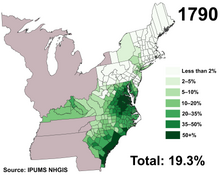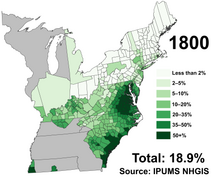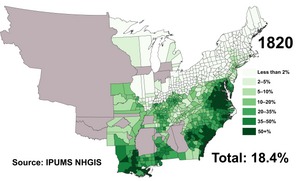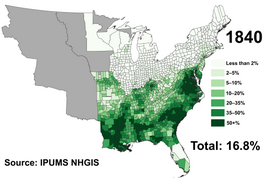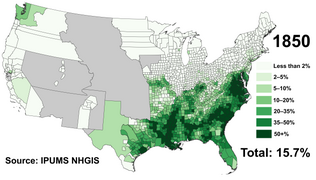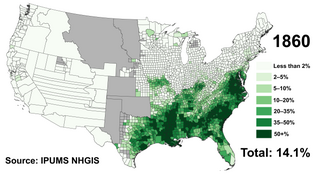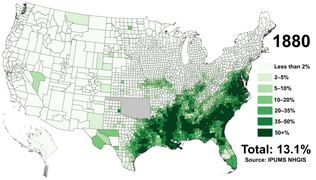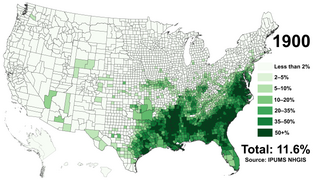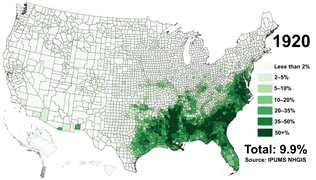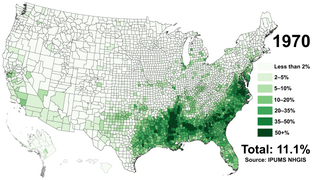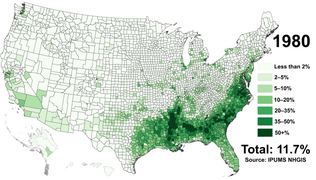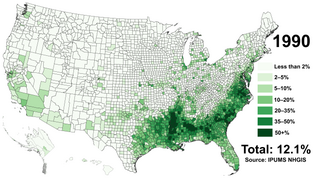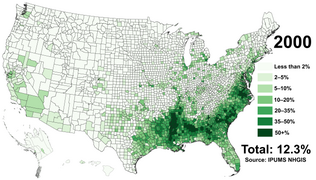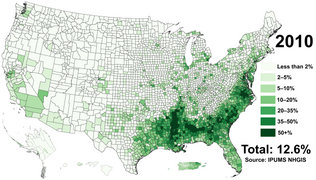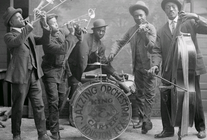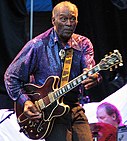African Americans
 Proportion of Black Americans in each county as of the2020 US census | |
| Total population | |
|---|---|
| Alone (one race) In combination (multiracial) Alone or in combination | |
| Regions with significant populations | |
| Predominantly in theSouthern United Statesandurban areas | |
| 3,552,997[1] | |
| 3,320,513[1] | |
| 3,246,381[1] | |
| 2,986,172[1] | |
| 2,237,044[1] | |
| Languages | |
| English (American English dialects,African-American English,African-American Vernacular English) Gullah Creole English Black American Sign Language | |
| Religion | |
| PredominantlyProtestant(71%) includingHistorically Black Protestant(53%),Evangelical Protestant(14%), andMainline Protestant(4%); significant[note 1]others includeCatholic(5%),Jehovah's Witnesses(2%),Muslim(2%), andunaffiliated(18%).[2] | |
| Part ofa serieson |
| African Americans |
|---|
African Americans,also known asBlack AmericansorAfro-Americans,are anethnic groupconsisting ofAmericanswith partial or total ancestry from any of theBlackracial groups ofAfrica.[3][4]African Americans constitute the second largest ethno-racial group in the US afterWhite Americans.[5]The term "African American" generally denotes descendants ofAfricans enslaved in the United States.[6][7]
Most African Americans are descendants of enslaved people within the boundaries of the present United States.[8][9]While some Black immigrants or their children may also come to identify as African American, the majority of first-generation immigrants do not, preferring to identify with their nation of origin.[10][11]Most African Americans are ofWest Africanand coastalCentral Africanancestry, with varying amounts ofWestern EuropeanandNative Americanancestry.[12]
African-American historybegan in the 16th century, with Africans from West Africa and coastal Central Africa being sold toEuropean slave tradersandtransported across the Atlantictothe Western Hemisphere.After arriving in theAmericas,they weresold as slavesto European colonists and put to work onplantations,particularlyin the southern colonies.A few were able to achieve freedom throughmanumissionor escape and founded independent communities before and during theAmerican Revolution.After the United States was founded in 1783, mostBlack people continued to be enslaved,being most concentrated in theAmerican South,with four million enslaved onlyliberatedduring and at the end of theCivil Warin 1865.[13]DuringReconstruction,they gainedcitizenshipand adult-males theright to vote;due to the widespread policy and ideology ofWhite supremacy,they were largely treated assecond-class citizensand found themselves soondisenfranchised in the South.These circumstances changed due to participation in themilitary conflicts of the United States,substantialmigration out of the South,the elimination of legalracial segregation,and thecivil rights movementwhich sought political and social freedom. However,racism against African Americansandracial socioeconomic disparityremains a problem into the 21st century.
In the 20th and 21st centuries, immigration has played an increasingly significant role in the African-American community. As of 2022, 10% of black Americans were immigrants, and 20% were either immigrants or the children of immigrants.[14]In 2008,Barack Obamabecame the first, and so far only African American to be elected president of the United States.[15]Kamala Harrisbecame the nation's first African-American vice president in 2020.
African-American culturehas had a significant influence on worldwide culture, making numerous contributions tovisual arts,literature,the English language,philosophy,politics,cuisine,sports, andmusic.The African-American contribution to popular music is so profound that most American music, includingjazz,gospel,blues,rock and roll,funk,disco,hip hop,R&B,trap,andsoul,has its origins either partially or entirely in the African-American community.[16][17]
History
Colonial era

The vast majority of those who were enslaved and transported in thetransatlantic slave tradewere people from severalCentralandWest Africaethnic groups, who had been captured directly by the slave traders in coastal raids,[18]or sold by other West Africans, or by half-European "merchant princes"[19]to European slave traders, who brought them to the Americas.[20]
The first African slaves arrived viaSanto Domingoin the Caribbean to theSan Miguel de Gualdapecolony (most likely located in theWinyah Bayarea of present-daySouth Carolina), founded by Spanish explorerLucas Vázquez de Ayllónin 1526.[21]The ill-fated colony was almost immediately disrupted by a fight over leadership, during which the slaves revolted and fled the colony to seek refuge among localNative Americans.De Ayllón and many of the colonists died shortly afterward of an epidemic and the colony was abandoned. The settlers and the slaves who had not escaped returned to the Island ofHispaniola,whence they had come.[21]
The marriage between Luisa de Abrego, a free Black domestic servant fromSeville,and Miguel Rodríguez, a WhiteSegovianconquistador in 1565 inSt. Augustine(Spanish Florida), is the first known and recorded Christian marriage anywhere in what is now the continental United States.[22]

The first recorded Africans inEnglish America(including most of the future United States) were"20 and odd negroes"who came toJamestown,VirginiaviaCape Comfortin August 1619 asindentured servants.[23]As many Virginian settlers began to die from harsh conditions, more and more Africans were brought to work as laborers.[24]
An indentured servant (who could be White or Black) would work for several years (usually four to seven) without wages. The status of indentured servants in early Virginia and Maryland was similar to slavery. Servants could be bought, sold, or leased and they could be physically beaten for disobedience or running away. Unlike slaves, they were freed after their term of service expired or was bought out, their children did not inherit their status, and on their release from contract they received "a year's provision of corn, double apparel, tools necessary", and a small cash payment called "freedom dues".[25]Africans could legally raise crops and cattle to purchase their freedom.[26]They raised families, married other Africans and sometimesintermarriedwith Native Americans or Europeansettlers.[27]
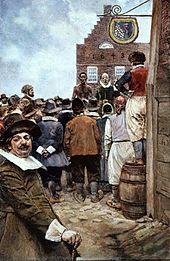
By the 1640s and 1650s, several African families owned farms aroundJamestownand some became wealthy by colonial standards and purchased indentured servants of their own. In 1640, the Virginia General Court recorded the earliest documentation of lifetime slavery when they sentencedJohn Punch,a Negro, to lifetime servitude under his masterHugh Gwynfor running away.[29][30]
In theSpanish FloridasomeSpanishmarried or hadunions withPensacola,CreekorAfricanwomen, both slave and free, and their descendants created a mixed-race population ofmestizosandmulattos.The Spanish encouraged slaves from thecolony of Georgiato come to Florida as a refuge, promising freedom in exchange for conversion toCatholicism.King Charles IIissued a royal proclamation freeing all slaves who fled to Spanish Florida and accepted conversion and baptism. Most went to the area aroundSt. Augustine,but escaped slaves also reached Pensacola. St. Augustine had mustered an all-Blackmilitiaunit defending Spanish Florida as early as 1683.[31]
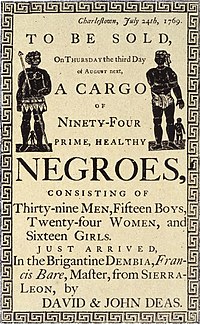
One of the Dutch African arrivals,Anthony Johnson,would later own one of the first Black "slaves",John Casor,resulting from the court ruling of a civil case.[32][33]
The popular conception of a race-based slave system did not fully develop until the 18th century. TheDutch West India Companyintroduced slavery in 1625 with the importation of eleven Black slaves intoNew Amsterdam(present-dayNew York City). All the colony's slaves, however, were freed upon its surrender to the English.[34]
Massachusettswas the first English colony to legally recognize slavery in 1641. In 1662, Virginia passed a law that children of enslaved women took the status of the mother, rather than that of the father, as undercommon law.This legal principle was calledpartus sequitur ventrum.[35][36]
By an act of 1699, Virginia ordered all free Blacks deported, virtually defining as slaves all people of African descent who remained in the colony.[37]In 1670, the colonial assembly passed a law prohibiting free and baptized Blacks (and Native Americans) from purchasing Christians (in this act meaning White Europeans) but allowing them to buy people "of their owne nation".[38]
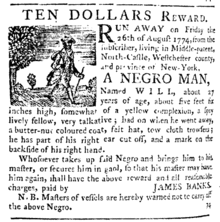
In theSpanish Louisianaalthough there was no movement toward abolition of the African slave trade, Spanish rule introduced a new law calledcoartación,which allowed slaves to buy their freedom, and that of others.[41]Although some did not have the money to buy their freedom, government measures on slavery allowed many free Blacks. That brought problems to the Spaniards with theFrench creoles(French who had settled inNew France) who continued on and also populated Spanish Louisiana, French creoles cited that measure as one of the system's worst elements.[42]
First established in South Carolina in 1704, groups of armed White men—slave patrols—were formed to monitor enslaved Black people.[43]Their function was to police slaves, especially fugitives. Slave owners feared that slaves might organize revolts orslave rebellions,so state militias were formed in order to provide a military command structure and discipline within the slave patrols so they could be used to detect, encounter, and crush any organized slave meetings which might lead to revolts orrebellions.[43]
The earliest African American congregations and churches were organized before 1800 in both northern and southern cities following theGreat Awakening.By 1775, Africans made up 20% of the population in theAmerican colonies,which made them the second largest ethnic group afterEnglish Americans.[44]
From the American Revolution to the Civil War
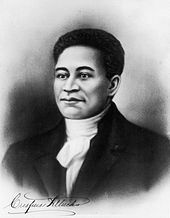
During the 1770s, Africans, both enslaved and free, helped rebellious American colonists secure their independence by defeating the British in theAmerican Revolutionary War.[45]Blacks played a role in both sides in the American Revolution. Activists in the Patriot cause includedJames Armistead,Prince Whipple,andOliver Cromwell.[46][47]Around 15,000Black Loyalistsleft with the British after the war, most of them ending up as free Black people in England[48]or its colonies, such as theBlack Nova Scotiansand theSierra Leone Creole people.[49][50]
In theSpanish Louisiana,GovernorBernardo de Gálvezorganized Spanish free Black men into two militia companies to defendNew Orleansduring the American Revolution. They fought in the 1779 battle in which Spain capturedBaton Rougefrom the British. Gálvez also commanded them in campaigns against the British outposts inMobile,Alabama,andPensacola,Florida. He recruited slaves for the militia by pledging to free anyone who was seriously wounded and promised to secure a low price forcoartación(buy their freedom and that of others) for those who received lesser wounds. During the 1790s, GovernorFrancisco Luis Héctor, baron of Carondeletreinforced local fortifications and recruit even more free Black men for the militia. Carondelet doubled the number of free Black men who served, creating two more militia companies—one made up of Black members and the other ofpardo(mixed race). Serving in the militia brought free Black men one step closer to equality with Whites, allowing them, for example, the right to carry arms and boosting their earning power. However, actually these privileges distanced free Black men from enslaved Blacks and encouraged them to identify with Whites.[42]
Slavery had been tacitly enshrined in theUS Constitutionthrough provisions such as Article I, Section 2, Clause 3, commonly known as the3/5 compromise.Because ofSection 9, Clause 1,Congress was unable to pass anAct Prohibiting Importation of Slavesuntil 1807.[51]Fugitive slave laws(derived from theFugitive Slave Clauseof the Constitution—Article IV, Section 2, Clause 3) were passed by Congress in1793and1850,guaranteeing the right for a slaveholder to recover an escaped slave within the US.[40]Slave owners, who viewed slaves as property, made it a federal crime to assist those who had escaped slavery or to interfere with their capture.[39]Slavery, which by then meant almost exclusively Black people, was the most important political issue in theAntebellum United States,leading to one crisis after another. Among these were theMissouri Compromise,theCompromise of 1850,theDred Scott decision,andJohn Brown's raid on Harpers Ferry.

Prior to theCivil War,eight serving presidents owned slaves, a practice protected by the US Constitution.[52]By 1860, there were 3.5 to 4.4 million enslaved Black people in the US due to theAtlantic slave trade,and another 488,000–500,000 Blacks lived free (with legislated limits)[53]across the country.[54]With legislated limits imposed upon them in addition to "unconquerable prejudice" from Whites according toHenry Clay,[55]some Black people who were not enslaved left the US forLiberiain West Africa.[53]Liberia began as a settlement of theAmerican Colonization Society(ACS) in 1821, with the abolitionist members of the ACS believing Blacks would face better chances for freedom and equality in Africa.[53]
The slaves not only constituted a large investment, they produced America's most valuable product and export:cotton.They helped build theUnited States Capitol,theWhite Houseand otherWashington, D.C.-basedbuildings.[56]) Similar building projects existed in theslave states.
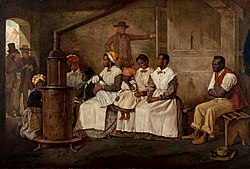
By 1815, thedomestic slave tradehad become a major economic activity in the United States; it lasted until the 1860s.[57]Historians estimate nearly one million in total took part in the forced migration of this new "Middle Passage". The historianIra Berlincalled this forced migration of slaves the "central event" in the life of a slave between the American Revolution and the Civil War, writing that whether slaves were directly uprooted or lived in fear that they or their families would be involuntarily moved, "the massive deportation traumatized black people".[58]Individuals lost their connection to families and clans, and many ethnic Africans lost their knowledge of varying tribal origins in Africa.[57]
The 1863 photograph ofWilson Chinn,a branded slave from Louisiana, like the one ofGordonand his scarred back, served as two early examples of how the newborn medium of photography could encapsulate the cruelty of slavery.[59]

Emigration of free Blacks to their continent of origin had been proposed since the Revolutionary war. AfterHaitibecame independent, it tried to recruit African Americans to migrate there after it re-established trade relations with the United States. The Haitian Union was a group formed to promote relations between the countries.[60]After riots against Blacks inCincinnati,its Black community sponsored founding of theWilberforce Colony,an initially successful settlement of African American immigrants to Canada. The colony was one of the first such independent political entities. It lasted for a number of decades and provided a destination for about 200 Black families emigrating from a number of locations in the United States.[60]
In 1863, during theAmerican Civil War,PresidentAbraham Lincolnsigned theEmancipation Proclamation.The proclamation declared that all slaves in Confederate-held territory were free.[61]Advancing Union troops enforced the proclamation, with Texas being the last state to be emancipated, in 1865.[62]
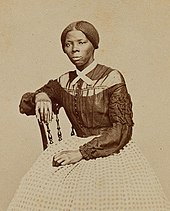
Slavery in a few border states continued until the ratification of theThirteenth Amendmentin December 1865.[63]While theNaturalization Act of 1790limited US citizenship to Whites only,[64][65]the14th Amendment(1868) gave Black people citizenship, and the15th Amendment(1870) gave Black men the right to vote.[66]
Reconstruction era and Jim Crow
African Americans quickly set up congregations for themselves, as well as schools and community/civic associations, to have space away from White control or oversight. While the post-war Reconstruction era was initially a time of progress for African Americans, that period ended in 1876. By the late 1890s, Southern states enacted Jim Crow laws to enforceracial segregationanddisenfranchisement.[67]Segregation was now imposed with Jim Crow laws, using signs used to show Blacks where they could legally walk, talk, drink, rest, or eat.[68]For those places that were racially mixed, non-Whites had to wait until all White customers were dealt with.[68]Most African Americans obeyed the Jim Crow laws, to avoidracially motivated violence.To maintain self-esteem and dignity, African Americans such asAnthony OvertonandMary McLeod Bethunecontinued to build their ownschools,churches,banks, social clubs, and other businesses.[69]
In the last decade of the 19th century, racially discriminatory laws and racial violence aimed at African Americans began to mushroom in the United States, a period often referred to as the "nadir of American race relations".These discriminatory acts included racial segregation—upheld by the United States Supreme Court decision inPlessy v. Fergusonin 1896—which was legally mandated by southern states and nationwide at the local level of government,voter suppressionor disenfranchisement in the southern states, denial of economic opportunity or resources nationwide, and private acts of violence and mass racial violence aimed at African Americans unhindered or encouraged by government authorities.[70]
Great migration and civil rights movement

The desperate conditions of African Americans in the South sparked theGreat Migrationduring the first half of the 20th century which led to a growing African American community inNorthernand Western United States.[72]The rapid influx of Blacks disturbed the racial balance within Northern and Western cities, exacerbating hostility between both Blacks and Whites in the two regions.[73]TheRed Summerof 1919 was marked by hundreds of deaths and higher casualties across the US as a result of race riots that occurred in more than three dozen cities, such as theChicago race riot of 1919and theOmaha race riot of 1919.Overall, Blacks in Northern and Western cities experiencedsystemic discriminationin a plethora of aspects of life. Within employment, economic opportunities for Blacks were routed to the lowest-status and restrictive in potential mobility. At the 1900Hampton Negro Conference,Reverend Matthew Anderson said: "...the lines along most of the avenues of wage earning are more rigidly drawn in the North than in the South."[74]Within the housing market, stronger discriminatory measures were used in correlation to the influx, resulting in a mix of "targeted violence,restrictive covenants,redliningandracial steering".[75]While many Whites defended their space with violence, intimidation, or legal tactics toward African Americans, many other Whites migrated to more racially homogeneous suburban or exurban regions, a process known asWhite flight.[76]

Despite discrimination, drawing cards for leaving the hopelessness in the South were the growth of African American institutions and communities in Northern cities. Institutions included Black oriented organizations (e.g.,Urban League,NAACP), churches, businesses, and newspapers, as well as successes in the development in African American intellectual culture, music, and popular culture (e.g.,Harlem Renaissance,Chicago Black Renaissance). TheCotton Clubin Harlem was a Whites-only establishment, with Blacks (such asDuke Ellington) allowed to perform, but to a White audience.[77]Black Americans also found a new ground for political power in Northern cities, without the enforced disabilities ofJim Crow.[78][79]
By the 1950s, thecivil rights movementwas gaining momentum. A 1955 lynching that sparked public outrage about injustice was that ofEmmett Till,a 14-year-old boy from Chicago. Spending the summer with relatives inMoney, Mississippi,Till was killed for allegedly havingwolf-whistledat a White woman. Till had been badly beaten, one of his eyes was gouged out, and he was shot in the head. The visceral response to his mother's decision to have an open-casket funeral mobilized the Black community throughout the US.[80]Vann R. Newkirk wrote "the trial of his killers became a pageant illuminating the tyranny ofWhite supremacy".[80]The state of Mississippi tried two defendants, but they were speedily acquitted by anall-White jury.[81]One hundred days after Emmett Till's murder,Rosa Parksrefused to give up her seat on the bus in Alabama—indeed, Parks told Emmett's motherMamie Tillthat "the photograph of Emmett's disfigured face in the casket was set in her mind when she refused to give up her seat on the Montgomery bus."[82]

TheMarch on Washington for Jobs and Freedomand the conditions which brought it into being are credited with putting pressure on presidentsJohn F. KennedyandLyndon B. Johnson.Johnson put his support behind passage of theCivil Rights Act of 1964that banned discrimination in public accommodations, employment, andlabor unions,and theVoting Rights Actof 1965, which expanded federal authority over states to ensure Black political participation through protection of voter registration and elections.[83]By 1966, the emergence of theBlack Powermovement, which lasted from 1966 to 1975, expanded upon the aims of the civil rights movement to include economic and political self-sufficiency, and freedom from White authority.[84]
During the post-war period, many African Americans continued to be economically disadvantaged relative to other Americans. Average Black income stood at 54 percent of that of White workers in 1947, and 55 percent in 1962. In 1959, median family income for Whites was $5,600 (equivalent to $58,532 in 2023), compared with $2,900 (equivalent to $30,311 in 2023) for non-White families. In 1965, 43 percent of all Black families fell into the poverty bracket, earning under $3,000 (equivalent to $29,005 in 2023) a year. The 1960s saw improvements in the social and economic conditions of many Black Americans.[85]
From 1965 to 1969, Black family income rose from 54 to 60 percent of White family income. In 1968, 23 percent of Black families earned under $3,000 (equivalent to $26,285 in 2023) a year, compared with 41 percent in 1960. In 1965, 19 percent of Black Americans had incomes equal to the national median, a proportion that rose to 27 percent by 1967. In 1960, the median level of education for Blacks had been 10.8 years, and by the late 1960s, the figure rose to 12.2 years, half a year behind the median for Whites.[85]
Post–civil rights era
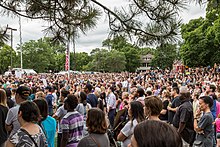
Politically and economically, African Americans have made substantial strides during the post–civil rights era. In 1967,Thurgood Marshallbecame thefirst African AmericanSupreme Court Justice. In 1968,Shirley Chisholmbecame the first Black woman elected to theUS Congress.In 1989,Douglas Wilderbecame the first African American elected governor in US history.Clarence Thomassucceeded Marshall to become the second African American Supreme Court Justice in 1991. In 1992,Carol Moseley-BraunofIllinoisbecame the first African American woman elected to theUS Senate.There were 8,936 Black officeholders in the United States in 2000, showing a net increase of 7,467 since 1970. In 2001, there were 484 Black mayors.[86]
In 2005, the number of Africans immigrating to the United States, in a single year, surpassed the peak number who were involuntarily brought to the United States during theAtlantic slave trade.[87]On November 4, 2008,DemocraticSenatorBarack Obama—the son of a White American mother and a Kenyan father—defeatedRepublicanSenatorJohn McCainto become the first African American to be elected president. At least 95 percent of African American voters voted for Obama.[88][89]He also received overwhelming support from young and educated Whites, a majority ofAsians,[90]andHispanics,[90]picking up a number of new states in the Democratic electoral column.[88][89]Obama lost the overall White vote, although he won a larger proportion of White votes than any previous non-incumbent Democratic presidential candidate sinceJimmy Carter.[91]Obama wasreelectedfor a second andfinal term,by a similar margin on November 6, 2012.[92]In 2021,Kamala Harris,the daughter of a Jamaican father and Indian mother, became the first woman, the first African American, and the firstAsian Americanto serve asVice President of the United States.[93]In June 2021,Juneteenth,a day which commemorates the end of slavery in the US, became a federal holiday.[94]
Demographics

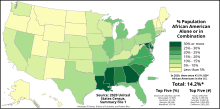



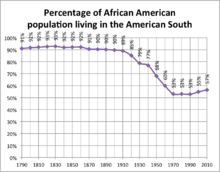
In 1790, when thefirst US censuswas taken, Africans (including slaves and free people) numbered about 760,000—about 19.3% of the population. In 1860, at the start of theCivil War,the African American population had increased to 4.4 million, but the percentage rate dropped to 14% of the overall population of the country. The vast majority were slaves, with only 488,000 counted as "freemen".By 1900, the Black population had doubled and reached 8.8 million.[95]
In 1910, about 90% of African Americans lived in the South. Large numbers began migrating north looking for better job opportunities and living conditions, and to escapeJim Crow lawsand racial violence. TheGreat Migration,as it was called, spanned the 1890s to the 1970s. From 1916 through the 1960s, more than 6 millionBlack peoplemoved north. But in the 1970s and 1980s,that trend reversed,with more African Americans moving south to theSun Beltthan leaving it.[96]
The following table of the African American population in the United States over time shows that the African American population, as a percentage of the total population, declined until 1930 and has been rising since then.
| Year | Number | % of total population |
% Change (10 yr) |
Slaves | % in slavery |
|---|---|---|---|---|---|
| 1790 | 757,208 | 19.3% (highest) | – | 697,681 | 92% |
| 1800 | 1,002,037 | 18.9% | 32.3% | 893,602 | 89% |
| 1810 | 1,377,808 | 19.0% | 37.5% | 1,191,362 | 86% |
| 1820 | 1,771,656 | 18.4% | 28.6% | 1,538,022 | 87% |
| 1830 | 2,328,642 | 18.1% | 31.4% | 2,009,043 | 86% |
| 1840 | 2,873,648 | 16.8% | 23.4% | 2,487,355 | 87% |
| 1850 | 3,638,808 | 15.7% | 26.6% | 3,204,287 | 88% |
| 1860 | 4,441,830 | 14.1% | 22.1% | 3,953,731 | 89% |
| 1870 | 4,880,009 | 12.7% | 9.9% | – | – |
| 1880 | 6,580,793 | 13.1% | 34.9% | – | – |
| 1890 | 7,488,788 | 11.9% | 13.8% | – | – |
| 1900 | 8,833,994 | 11.6% | 18.0% | – | – |
| 1910 | 9,827,763 | 10.7% | 11.2% | – | – |
| 1920 | 10.5 million | 9.9% | 6.8% | – | – |
| 1930 | 11.9 million | 9.7% (lowest) | 13% | – | – |
| 1940 | 12.9 million | 9.8% | 8.4% | – | – |
| 1950 | 15.0 million | 10.0% | 16% | – | – |
| 1960 | 18.9 million | 10.5% | 26% | – | – |
| 1970 | 22.6 million | 11.1% | 20% | – | – |
| 1980 | 26.5 million | 11.7% | 17% | – | – |
| 1990 | 30.0 million | 12.1% | 13% | – | – |
| 2000 | 34.6 million | 12.3% | 15% | – | – |
| 2010 | 38.9 million | 12.6% | 12% | – | – |
| 2020 | 41.1 million | 12.4% | 5.6% | – | – |
By 1990, the African American population reached about 30 million and represented 12% of the US population, roughly the same proportion as in 1900.[98]
| Years | Non-Hispanic Blacks | Black Hispanics | Total | ||
|---|---|---|---|---|---|
| # | % | # | % | ||
| 2020 | 39,940,338 | 12.05% | 1,163,862 | 0.35% | 41,104,200 |
At the time of the2000 US census,54.8% of African Americans lived in theSouth.In that year, 17.6% of African Americans lived in theNortheastand 18.7% in theMidwest,while only 8.9% lived in theWesternstates. The west does have a sizable Black population in certain areas, however. California, the nation's most populous state, has the fifth largest African American population, only behind New York, Texas, Georgia, and Florida. According to the 2000 census, approximately 2.05% ofAfrican Americans identified as Hispanic or Latino in origin,[99]many of whom may be ofBrazilian,Puerto Rican,Dominican,Cuban,Haitian,or otherLatin Americandescent. The only self-reportedancestralgroups larger than African Americans are theIrishandGermans.[100]

According to the2010 census,nearly 3% of people who self-identified as Black had recent ancestors who immigrated from another country. Self-reportednon-Hispanic Black immigrants from the Caribbean,mostly from Jamaica and Haiti, represented 0.9% of the US population, at 2.6 million.[102]Self-reported Black immigrants from sub-Saharan Africa also represented 0.9%, at about 2.8 million.[102]Additionally, self-identifiedBlack Hispanicsrepresented 0.4% of the United States population, at about 1.2 million people, largely found within the Puerto Rican and Dominican communities.[103]Self-reported Black immigrants hailing from other countries in the Americas, such as Brazil and Canada, as well as several European countries, represented less than 0.1% of the population. Mixed-race Hispanic and non-Hispanic Americans who identified as being part Black, represented 0.9% of the population. Of the 12.6% of United States residents who identified as Black, around 10.3% were "native Black American" or ethnic African Americans, who are direct descendants of West/Central Africans brought to the US as slaves. These individuals make up well over 80% of all Blacks in the country. When includingpeople of mixed-race origin,about 13.5% of the US population self-identified as Black or "mixed with Black".[104]However, according to the US Census Bureau, evidence from the 2000 census indicates that many African and Caribbean immigrant ethnic groups do not identify as "Black, African Am., or Negro". Instead, they wrote in their own respective ethnic groups in the "Some Other Race" write-in entry. As a result, the census bureau devised a new, separate "African American" ethnic group category in 2010 for ethnic African Americans.[105]Nigerian AmericansandEthiopian Americanswere the most reported sub-Saharan African groups in the United States.[106]
Historically, African Americans have been undercounted in the US census due to a number of factors.[example needed][107][108]In the 2020 census, the African American population was undercounted at an estimated rate of 3.3%, up from 2.1% in 2010.[109]
Proportion in each county
- African American (Alone) population distribution over time
-
1790
-
1800
-
1810
-
1820
-
1830
-
1840
-
1850
-
1860
-
1870
-
1880
-
1890
-
1900
-
1910
-
1920
-
1930
-
1940
-
1970
-
1980
-
1990
-
2000
-
2010
-
2020
Texashas the largest African American population by state. Followed by Texas isFlorida,with 3.8 million, andGeorgia,with 3.6 million.[110]
US cities
After 100 years of African Americans leaving the south in large numbers seeking better opportunities and treatment in the west and north, a movement known as theGreat Migration,there is now a reverse trend, called theNew Great Migration.As with the earlier Great Migration, the New Great Migration is primarily directed toward cities and large urban areas, such asCharlotte,Houston,Dallas,Fort Worth,Huntsville,Raleigh,Tampa,San Antonio,New Orleans,Memphis,Nashville,Jacksonville,and so forth.[111]A growing percentage of African Americans from the west and north are migrating to the southern region of the US for economic and cultural reasons. TheNew York City,Chicago,andLos Angelesmetropolitan areas have the highest decline in African Americans, whileAtlanta,Dallas,andHoustonhave the highest increase respectively.[111]Several smaller metro areas also saw sizable gains, including San Antonio;[112]Raleigh and Greensboro, N.C.; and Orlando.[113]Despite recent declines, as of 2020, theNew York City metropolitan areastill has the largest African American metropolitan population in the United States and the only to have over 3 million African Americans.[114][115]
Amongcities of 100,000 or more,South Fulton, Georgiahad the highest percentage of Black residents of any large US city in 2020, with 93%. Other large cities with African American majorities includeJackson, Mississippi(80%),Detroit, Michigan(80%),Birmingham, Alabama(70%),Miami Gardens, Florida(67%),Memphis, Tennessee(63%),Montgomery, Alabama(62%),Baltimore, Maryland(60%),Augusta, Georgia(59%),Shreveport, Louisiana(58%),New Orleans, Louisiana(57%),Macon, Georgia(56%),Baton Rouge, Louisiana(55%),Hampton, Virginia(53%),Newark, New Jersey(53%),Mobile, Alabama(53%),Cleveland, Ohio(52%),Brockton, Massachusetts(51%), andSavannah, Georgia(51%).
The nation's most affluent community with an African American majority resides inView Park–Windsor Hills, California,with an annual median household income of $159,618.[116]Other largely affluent and African American communities includePrince George's County(namelyMitchellville,Woodmore,Upper Marlboro) andCharles Countyin Maryland,[117]Dekalb County(namelyStonecrest,Lithonia,Smoke Rise) and South Fulton in Georgia,Charles City Countyin Virginia,Baldwin Hillsin California,HillcrestandUniondalein New York, andCedar Hill,DeSoto,andMissouri Cityin Texas.Queens County, New Yorkis the only county with a population of 65,000 or more where African Americans have a higher median household income than White Americans.[118]
Seatack, Virginiais currently the oldest African American community in the United States.[119]It survives today with a vibrant and active civic community.[120]
Education
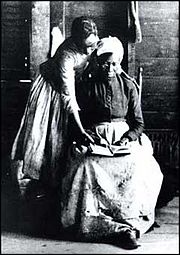
During slavery,anti-literacy lawswere enacted in the US that prohibited education for Black people. Slave owners saw literacy as a threat to the institution of slavery. As a North Carolina statute stated, "Teaching slaves to read and write, tends to excite dissatisfaction in their minds, and to produce insurrection andrebellion."[121]
When slavery was finally abolished in 1865, public educational systems were expanding across the country. By 1870, around seventy-four institutions in the south provided a form of advanced education for African American students. By 1900, over a hundred programs at these schools provided training for Black professionals, including teachers. Many of the students at Fisk University, including the youngW. E. B. Du Bois,taught school during the summers to support their studies.[122]
African Americans were very concerned to provide quality education for their children, but White supremacy limited their ability to participate in educational policymaking on the political level. State governments soon moved to undermine their citizenship by restricting their right to vote. By the late 1870s, Blacks were disenfranchised and segregated across the American South.[123]White politicians in Mississippi and other states withheld financial resources and supplies from Black schools. Nevertheless, the presence of Black teachers, and their engagement with their communities both inside and outside the classroom, ensured that Black students had access to education despite these external constraints.[124][125]
DuringWorld War II,demands for unity and racial tolerance on the home front provided an opening for the first Black history curriculum in the country.[126]For example, during the early 1940s, Madeline Morgan, a Black teacher in the Chicago public schools, created a curriculum for students in grades one through eight highlighting the contributions of Black people to the history of the United States. At the close of the war, Chicago's Board of Education downgraded the curriculum's status from mandatory to optional.[127]
Predominantly Black schools for kindergarten through twelfth grade students were common throughout the US before the 1970s. By 1972, however, desegregation efforts meant that only 25% of Black students were in schools with more than 90% non-White students. However, since then, a trend towards re-segregation affected communities across the country: by 2011, 2.9 million African American students were in such overwhelmingly minority schools, including 53% of Black students in school districts that were formerly under desegregation orders.[128][129]
As late as 1947, about one third of African Americans over 65 were considered to lack the literacy to read and write their own names. By 1969,illiteracyas it had been traditionally defined, had been largely eradicated among younger African Americans.[130]
US census surveys showed that by 1998, 89 percent of African Americans aged 25 to 29 had completed a high-school education, less than Whites or Asians, but more than Hispanics. On many college and university entrance exams or on standardized tests and grades, African Americans have historically lagged behind Whites, but some studies suggest that theachievement gaphas been closing. Many policy makers have proposed that this gap can and will be eliminated through policies such asaffirmative action,desegregation, and multiculturalism.[131]
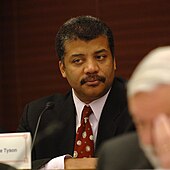
Between 1995 and 2009, freshmen college enrollment for African Americans increased by 73 percent and only 15 percent for Whites.[132]Black women are enrolled in college more than any other race and gender group, leading all with 9.7% enrolled according to the 2011 US census.[133][134] The average high school graduation rate of Blacks in the United States has steadily increased to 71% in 2013.[135]Separating this statistic into component parts shows it varies greatly depending upon the state and the school district examined. 38% of Black males graduated in the state of New York but in Maine 97% graduated and exceeded the White male graduation rate by 11 percentage points.[136]In much of the southeastern United States and some parts of the southwestern United States the graduation rate of White males was in fact below 70% such as in Florida where 62% of White males graduated from high school. Examining specific school districts paints an even more complex picture. In the Detroit school district, the graduation rate of Black males was 20% but 7% for White males. In the New York City school district 28% of Black males graduate from high school compared to 57% of White males. In Newark County[where?]76% of Black males graduated compared to 67% for White males. Further academic improvement has occurred in 2015. Roughly 23% of all Blacks have bachelor's degrees. In 1988, 21% of Whites had obtained a bachelor's degree versus 11% of Blacks. In 2015, 23% of Blacks had obtained a bachelor's degree versus 36% of Whites.[137]Foreign born Blacks, 9% of the Black population, made even greater strides. They exceed native born Blacks by 10 percentage points.[137]
College Board,which runs the official college-leveladvanced placement(AP) programs in American high schools, have has received criticism in recent years that its curricula have focused too much onEuro-centrichistory.[138]In 2020, College Board reshaped some curricula among history-based courses to further reflect theAfrican diaspora.[139]In 2021, College Board announced it would be piloting anAP African American Studiescourse between 2022 and 2024. The course is expected to launch in 2024.[140]
Historically Black colleges and universities
Historically Black colleges and universities (HBCUs), which were founded whensegregated institutionsof higher learning did not admit African Americans, continue to thrive and educate students of all races today. There are 101 HBCUs representing three percent of the nation's colleges and universities with the majority established in theSoutheast.[141][142]HBCUs have been largely responsible for establishing and expanding the African American middle-class by providing more career opportunities for African Americans.[143][144]
Economic status
The economic disparity between the races in the US has marginally improved since the end of slavery. In 1863, two years prior to emancipation, Black people owned 0.5 percent of the national wealth, while in 2019 it is just over 1.5 percent.[145]Racial disparity in poverty rateshas narrowed since the civil rights era, with thepoverty rate among African Americansdecreasing from 24.7% in 2004 to 18.8% in 2020, compared to 10.5% for all Americans.[146][147]Poverty is associated with higher rates of marital stress and dissolution,physicalandmental healthproblems,disability,cognitive deficits,low educational attainment,and crime.[148]
African Americans have a long and diverse history of business ownership. Although the first African American business is unknown, slaves captured from West Africa are believed to have established commercial enterprises as peddlers and skilled craftspeople as far back as the 17th century. Around 1900, Booker T. Washington became the most famous proponent of African American businesses. His critic and rival W. E. B. DuBois also commended business as a vehicle for African American advancement.[149]
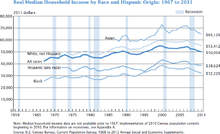
African Americans had a combined buying power of over $1.6 trillion as of 2021, a 171% increase of their buying power in 2000 but lagging significantly in growth behind AmericanLatinosandAsiansin the same timer period (with 288% and 383%, respectively; for reference, US growth overall was 144% in the same period); however, African American net worth had shrunk 14% in the previous year despite strong growth in property prices and theS&P 500.In 2002, African American-owned businesses accounted for 1.2 million of the US's 23 million businesses.[151]As of 2011[update],African American-owned businesses account for approximately 2 millionUS businesses.[152]Black-owned businesses experienced the largest growth in number of businesses among minorities from 2002 to 2011.[152]
Twenty-five percent of Blacks hadwhite-collaroccupations (management, professional, and related fields) in 2000, compared with 33.6% of Americans overall.[153][154]In 2001, over half of African American households of married couples earned $50,000 or more.[154]Although in the same year African Americans were over-represented among the nation's poor, this was directly related to the disproportionate percentage of African American families headed by single women; such families are collectively poorer, regardless of ethnicity.[154]
In 2006, the median earnings of African American men was more than Black and non-Black American women overall, and in all educational levels.[155][156][157][158][159]At the same time, among American men, income disparities were significant; the median income of African American men was approximately 76 cents for every dollar of their European American counterparts, although the gap narrowed somewhat with a rise in educational level.[155][160]
Overall, the median earnings of African American men were 72 cents for every dollar earned of their Asian American counterparts, and $1.17 for every dollar earned by Hispanic men.[155][158][161]On the other hand, by 2006, among American women with post-secondary education, African American women have made significant advances; the median income of African American women was more than those of their Asian-, European- and Hispanic American counterparts with at least some college education.[156][157][162]
The USpublic sectoris the single most important source of employment for African Americans.[163]During 2008–2010, 21.2% of all Black workers were public employees, compared with 16.3% of non-Black workers.[163]Both before and after the onset of theGreat Recession,African Americans were 30% more likely than other workers to be employed in the public sector.[163]The public sector is also a critical source of decent-paying jobs for Black Americans. For both men and women, the median wage earned by Black employees is significantly higher in the public sector than in other industries.[163]
In 1999, the median income of African American families was $33,255 compared to $53,356 of European Americans. In times of economic hardship for the nation, African Americans suffer disproportionately from job loss andunderemployment,with the Black underclass being hardest hit. The phrase "last hired and first fired" is reflected in theBureau of Labor Statisticsunemployment figures. Nationwide, the October 2008 unemployment rate for African Americans was 11.1%,[164]while the nationwide rate was 6.5%.[165]In 2007, the average income for African Americans was approximately $34,000, compared to $55,000 for Whites.[166]African Americans experience a higher rate of unemployment than the general population.[167]
The income gap between Black and White families is also significant. In 2005, employed Blacks earned 65% of the wages of Whites, down from 82% in 1975.[146]The New York Timesreported in 2006 that inQueens,New York, the median income among African American families exceeded that of White families, which the newspaper attributed to the growth in the number of two-parent Black families. It noted that Queens was the only county with more than 65,000 residents where that was true.[118]In 2011, it was reported that72% of Black babies were born to unwed mothers.[168]The poverty rate among single-parent Black families was 39.5% in 2005, according toWalter E. Williams,while it was 9.9% among married-couple Black families. Among White families, the respective rates were 26.4% and 6% in poverty.[169]
Collectively, African Americans are more involved in the American political process than other minority groups in the United States, indicated by the highest level of voter registration and participation in elections among these groups in 2004.[170]African Americans also have the highest level ofCongressional representationof any minority group in the US.[171]
African American homeownership

Homeownership in the USis the strongest indicator of financial stability and the primary asset most Americans use to generate wealth. African Americans continue to lag behind other racial groups in homeownership.[173]In the first quarter of 2021, 45.1% of African Americans owned their homes, compared to 65.3% of all Americans.[174]The African American homeownership rate has remained relatively flat since the 1970s despite an increase inanti-discrimination housing laws and protections.[175]The African American homeownership rate peaked in 2004 at 49.7%.[176]
The average White high school drop-out still has a slightly better chance of owning a home than the average African American college graduate usually due to unfavorabledebt-to-income ratiosorcredit scoresamong most African American college graduates.[177][178]Since 2000, fast-growing housing costs in most cities have made it even more difficult for the US African American homeownership rate to significantly grow and reach over 50% for the first time in history. From 2000 to 2022, the median home price in the US grew 160%, outpacing average annual household income growth in that same period, which only grew about 30%.[179][180][181]South Carolinais the state with the most African American homeownership, with about 55% of African Americans owning their own homes.[182][183]
Politics
| Year | Candidate of the plurality |
Political party |
% of black vote |
Result |
|---|---|---|---|---|
| 1980 | Jimmy Carter | Democratic | 83% | Lost |
| 1984 | Walter Mondale | Democratic | 91% | Lost |
| 1988 | Michael Dukakis | Democratic | 89% | Lost |
| 1992 | Bill Clinton | Democratic | 83% | Won |
| 1996 | Bill Clinton | Democratic | 84% | Won |
| 2000 | Al Gore | Democratic | 90% | Lost |
| 2004 | John Kerry | Democratic | 88% | Lost |
| 2008 | Barack Obama | Democratic | 95% | Won |
| 2012 | Barack Obama | Democratic | 93% | Won |
| 2016 | Hillary Clinton | Democratic | 88% | Lost |
| 2020 | Joe Biden | Democratic | 87% | Won |
Since the mid 20th century, a large majority of African Americans support theDemocratic Party.In the2020 Presidential election,91% of African American voters supported DemocratJoe Biden,while 8% supported RepublicanDonald Trump.[184]Although there is an African American lobby in foreign policy, it has not had the impact that African American organizations have had in domestic policy.[185]
Many African Americans were excluded from electoral politics in the decades following the end of Reconstruction. For those that could participate, until theNew Deal,African Americans were supporters of the Republican Party because it was Republican President Abraham Lincoln who helped in granting freedom to American slaves; at the time, the Republicans and Democrats represented thesectionalinterests of theNorthandSouth,respectively, rather than any specific ideology, and bothconservativeandliberalwere represented equally in both parties.
The African American trend of voting for Democrats can be traced back to the 1930s during theGreat Depression,whenFranklin D. Roosevelt'sNew Dealprogram provided economic relief to African Americans. Roosevelt'sNew Deal coalitionturned the Democratic Party into an organization of the working class and their liberal allies, regardless of region. The African American vote became even more solidly Democratic when Democratic presidentsJohn F. KennedyandLyndon B. Johnsonpushed for civil rights legislation during the 1960s. In 1960, nearly a third of African Americans voted for RepublicanRichard Nixon.[186]
Black national anthem
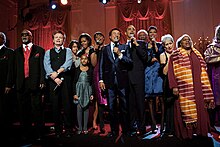
"Lift Every Voice and Sing"is often referred to as the Black national anthem in the United States.[187]In 1919, the National Association for the Advancement of Colored People (NAACP) had dubbed it the "Negro national anthem" for its power in voicing a cry for liberation and affirmation for African-American people.[188]
Sexuality
According to aGallup survey,4.6% of Black or African Americans self-identified asLGBTin 2016,[189]while the total portion of American adults in all ethnic groups identifying as LGBT was 4.1% in 2016.[189]African Americans are more likely to identify themselves as lesbian, gay, bisexual, or transgender than any other racial or ethnic group in the United States.[190]
Health
General health
The life expectancy for Black men in 2008 was 70.8 years.[191]Life expectancy for Black women was 77.5 years in 2008.[191]In 1900, when information on Black life expectancy started being collated, a Black man could expect to live to 32.5 years and a Black woman 33.5 years.[191]In 1900, White men lived an average of 46.3 years and White women lived an average of 48.3 years.[191]African American life expectancy at birth is persistently five to seven years lower thanEuropean Americans.[192]Black men have shorter lifespans than any other group in the US besides Native American men.[193]
Black people have higher rates ofobesity,diabetes,andhypertensionthan the US average.[191]For adult Black men, the rate of obesity was 31.6% in 2010.[194]For adult Black women, the rate of obesity was 41.2% in 2010.[194]African Americans have higher rates of mortality than any other racial or ethnic group for 8 of the top 10 causes of death.[195]In 2013, among men, Black men had the highest rate of getting cancer, followed by White, Hispanic, Asian/Pacific Islander (A/PI), and American Indian/Alaska Native (AI/AN) men. Among women, White women had the highest rate of getting cancer, followed by Black, Hispanic, Asian/Pacific Islander, and American Indian/Alaska Native women.[196]African Americans also have higher prevalence and incidence of Alzheimer's disease compared to the overall average.[197][198]
African-Americans are more likely than White Americans to die due to health-related problems developed byalcoholism.Alcohol abuse is the main contributor to the top 3 causes of death among African Americans.[199]
In December 2020, African Americans were less likely to bevaccinatedagainstCOVID-19due to mistrust in the US medical system. From 2021 to 2022, there was an increase in African Americans who became vaccinated.[200][201][202]Still, in 2022, COVID-19 complications became the third leading cause of death for African Americans.[203]
Violence is a major problem within the African American community.[204][205]A report from theUS Department of Justicestates "In 2005, homicide victimization rates for blacks were 6 times higher than the rates for whites".[206]The report also found that "94% of black victims were killed by blacks."[206]Of the nearly 20,000 recorded US homicides in 2022, African Americans made up the majority of offenders and victims despite making up less than 20% of the population.[207]In 2024, all of the top 5 most dangerous US cities have a significant black population and disturbing black-on-black violent crime rate.[208]Black males age 15–44 are the only race/sex category for which homicide is a top 5 cause of death.[193]Black women are 3 times more likely to be killed by an intimate partner than white women.[209]Black children are 3 times more likely to die due to parental abuse and neglect than white children.[210]
Sexual health
According to theCenters for Disease Control and Prevention,African Americans have higher rates ofsexually transmitted infections(STIs) compared to Whites, with 5 times the rates ofsyphilisandchlamydia,and 7.5 times the rate ofgonorrhea.[211]
The disproportionately high incidence ofHIV/AIDS among African Americanshas been attributed tohomophobicinfluences and lack of proper healthcare.[212]The prevalence ofHIV/AIDSamong Black men is seven times higher than the prevalence for White men, and Black men are more than nine times as likely to die from HIV/AIDS-related illness than White men.[193]
Mental health
African Americans have severalbarriers for accessing mental healthservices.Counselinghas been frowned upon and distant in utility and proximity to many people in the African American community. In 2004, a qualitative research study explored the disconnect with African Americans and mental health. The study was conducted as a semi-structured discussion which allowed the focus group to express their opinions and life experiences. The results revealed a couple key variables that create barriers for many African American communities to seek mental health services such as the stigma, lack of four important necessities; trust, affordability, cultural understanding and impersonal services.[213]
Historically, many African American communities did not seek counseling because religion was a part of the family values.[214]African American who have a faith background are more likely to seek prayer as a coping mechanism for mental issues rather than seeking professional mental health services.[213]In 2015 a study concluded, African Americans with high value in religion are less likely to utilize mental health services compared to those who have low value in religion.[215]
In the United States, counseling approaches are based on the experience ofWhite Americansand do not fit within the African American culture. African American families tend to resolve concerns within the family, and it is viewed by the family as a strength. On the other hand, when African Americans seek counseling, they face a social backlash and are criticized. They may be labeled "crazy", viewed as weak, and their pride is diminished.[213]Because of this, many African Americans instead seek mentorship within communities they trust.
Terminology is another barrier in relation to African Americans and mental health. There is more stigma on the termpsychotherapyversus counseling. In one study, psychotherapy is associated with mental illness whereas counseling approaches problem-solving, guidance and help.[213]More African Americans seek assistance when it is called counseling and not psychotherapy because it is more welcoming within the cultural and community.[216]Counselors are encouraged to be aware of such barriers for the well-being of African American clients. Withoutcultural competencytraining in health care, many African Americans go unheard and misunderstood.[213]
In 2021, African Americans had the third highestsuiciderate trailing American Indians/Alaska Natives and White Americans. However, African Americans had the second highest increase of its suicide rate from 2011 to 2021, growing 58%.[217]As of 2024, suicide is the second leading cause of death among African-Americans between the ages of 15 and 24, with black men being four times more likely to kill themselves than black women.[218]
Genetics
Genome-wide studies

Recent studies of African Americans using genetic testing have found ancestry to vary by region and sex of ancestors. These studies found that on average, African Americans have 73.2–82.1% Sub-Saharan African, 16.7%–24% European, and 0.8–1.2% Native American genetic ancestry, with large variation between individuals.[220][221][222]Commercial testing services have reported similar variation, with ranges from 0.6 to 2 percent Native American, 19 to 29 percent European, and 65 to 80 percent Sub-Saharan African ancestry.[223]
According to a genome-wide study by Bryc et al. (2009), the mixed ancestry of African Americans in varying ratios came about as the result of sexual contact between West/Central Africans (more frequently females) and Europeans (more frequently males). This can be understood as being the result of enslaved African American females beingrapedby White males.[224]Historians estimate that 58% of enslaved women in the US aged 15–30 years were sexually assaulted by their slave owners and other White men.[225]Consequently, the 365 African Americans in their sample have a genome-wide average of 78.1% West African ancestry and 18.5% European ancestry, with large variation among individuals (ranging from 99% to 1% West African ancestry). The West African ancestral component in African Americans is most similar to that in present-day speakers from the non-Bantubranches of theNiger-Congofamily.[220][note 2]
Correspondingly, Montinaro et al. (2014) observed that around 50% of the overall ancestry of African Americans traces comes from a population similar to the Niger-Congo-speakingYorubaof southernNigeriaand southernBenin,reflecting the centrality of this West African region in the Atlantic slave trade. The next most frequent ancestral component found among African Americans was derived from Great Britain, in keeping with historical records. It constitutes a little over 10% of their overall ancestry and is most similar to the Northwest European ancestral component also carried byBarbadians.[227]Zakharia et al. (2009) found a similar proportion of Yoruba-like ancestry in their African American samples, with a minority also drawn fromMandenkaandBantupopulations. Additionally, the researchers observed an average European ancestry of 21.9%, again with significant variation between individuals.[219]Bryc et al. (2009) note that populations from other parts of the continent may also constitute adequate proxies for the ancestors of some African American individuals; namely, ancestral populations fromGuinea Bissau,SenegalandSierra Leonein West Africa andAngolain Southern Africa.[220]An individual African American person can have over fifteen African ethnic groups in their genetic makeup alone due to the slave trade covering such vast areas.[228]
Altogether, genetic studies suggest that African Americans are a genetically diverse people. According to DNA analysis led in 2006 byPenn StategeneticistMark D. Shriver,around 58 percent of African Americans have at least 12.5% European ancestry (equivalent to one European great-grandparent and their forebears), 19.6 percent of African Americans have at least 25% European ancestry (equivalent to one European grandparent and their forebears), and 1 percent of African Americans have at least 50% European ancestry (equivalent to one European parent and their forebears).[12][229]According to Shriver, around 5 percent of African Americans also have at least 12.5% Native American ancestry (equivalent to one Native American great-grandparent and their forebears).[230][231]Research suggests that Native American ancestry among people who identify as African American is a result of relationships that occurred soon after slave ships arrived in the American colonies, and European ancestry is of more recent origin, often from the decades before the Civil War.[232]
Y-DNA
Africans bearing theE-V38(E1b1a) likely traversed across theSahara,fromeasttowest,approximately 19,000 years ago.[233]E-M2(E1b1a1) likely originated in West Africa or Central Africa.[234]According to aY-DNAstudy by Sims et al. (2007), the majority (≈60%) of African Americans belong to various subclades of theE-M2(E1b1a1, formerly E3a) paternal haplogroup. This is the most common genetic paternal lineage found today among West/Central African males and is also a signature of the historicalBantu migrations.The next most frequent Y-DNA haplogroup observed among African Americans is theR1bclade, which around 15% of African Americans carry. This lineage is most common today among Northwestern European males. The remaining African Americans mainly belong to the paternalhaplogroup I(≈7%), which is also frequent in Northwestern Europe.[235]
mtDNA
According to anmtDNAstudy by Salas et al. (2005), the maternal lineages of African Americans are most similar to haplogroups that are today especially common in West Africa (>55%), followed closely by West-Central Africa and Southwestern Africa (<41%). The characteristic West African haplogroupsL1b,L2b,c,d,andL3b,dand West-Central African haplogroupsL1candL3ein particular occur at high frequencies among African Americans. As with the paternal DNA of African Americans, contributions from other parts of the continent to their maternal gene pool are insignificant.[236]
Racism and social status
Formal political, economic and social discrimination against minorities has been present throughout American history. Leland T. Saito, Associate Professor of Sociology and American Studies & Ethnicity at theUniversity of Southern California,writes, "Political rights have been circumscribed by race, class and gender since the founding of the United States, when the right to vote was restricted to White men of property. Throughout the history of the United States, race has been used by Whites for legitimizing and creating difference and social, economic and political exclusion."[65]
Although they have gained a greater degree of social equality since the civil rights movement, African Americans have remained stagnant economically, which has hindered their ability to break into the middle class and beyond. As of 2020, theracial wealth gapbetween Whites and Blacks remains as large as it was in 1968, with the typical net worth of a White household equivalent to that of 11.5 black households.[237]Despite this, African Americans have increased employment rates and gained representation in the highest levels of American government in the post–civil rights era.[238]However, widespreadracismremains an issue that continues to undermine the development of social status.[238][239]
Economically, of all the racially Black ethnic groups on the globe, African Americans are the wealthiest and most successful, with one in every fifty African American families being millionaires.[240]This equates in 2023 to approximately 1.79 million African American millionaires in the United States,[241][242]which is more than the total amount of millionaires in any racially Black country, and many other countries, around the world.
Policing and criminal justice
In the US, which has the largest per-capita prison population in the world, African Americans are overrepresented as the second largest population of prison inmates (38%) in 2023, coming second to Whites who made up 57% of the prison population.[243]According to theNational Registry of Exonerations,Blacks are roughly 7.5 times more likely to be wrongfully convicted of murder in the US than Whites.[244]In 2012, the New York City Police Department detained people more than 500,000 times under the city'sstop-and-frisklaw. Of the total detained, 55% were African-Americans, while Black people made up 20% of the city's population.[245]

African American males are more likely to bekilled by policewhen compared to other races.[246]This is one of the factors that led to the creation of theBlack Lives Mattermovement in 2013.[247]A historical issue in the US where women have weaponized their White privilege in the country by reporting on Black people, often instigating racial violence,[248][249]difficult White women—who have been given adifferent name over the centuriesby African Americans—calling the police on Black people became widely publicized in 2020.[250][251]According toThe Guardian,"The specter ofKarenpersisted as Black Lives Matter protests and civil unrest spread around the country followingFloyd’s murderand reckonings with racism began to roil institutions, toppling careers as well as statues ".[252]
Although there is not enough evidence that suggest Black people consumecannabiswith greater regularity than Whites do, they have disproportionately higher arrest rates than Whites: in 2010, for example, Blacks were 3.73 times as likely to get arrested for using cannabis than Whites, despite not significantly more frequently being users.[253][254]Even since the legalization of cannabis, there are still more arrests made for Black users than White, wasting taxpayer money, due to many of those cases being abandoned or dropped, with no charges being filed after the trivial, racially-biased arrests.[255][256]
Social issues
After over 50 years, marriage rates for all Americans began to decline while divorce rates and out-of-wedlock births have climbed.[257]These changes have been greatest among African Americans. After more than 70 years of racial parity Black marriage rates began to fall behind Whites.[257]Single-parenthouseholds have become common, and according to US census figures released in January 2010, only 38 percent of Black children live with both their parents.[258]In 2021, statistics show that over 80 percent marriages in the African American ethnic group marry within their ethnic group.[259]
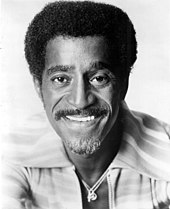
The first everanti-miscegenation lawwas passed by theMaryland General Assemblyin 1691, criminalizinginterracial marriage.[260]In a speech inCharleston, Illinoisin 1858,Abraham Lincolnstated, "I am not, nor ever have been in favor of making voters or jurors of negroes, nor of qualifying them to hold office, nor to intermarry with white people".[261]By the late 1800s, 38 US states had anti-miscegenation statutes.[260]By 1924, the ban on interracial marriage was still in force in 29 states.[260]While interracial marriage had been legal in California since 1948, in 1957 actorSammy Davis Jr.faced a backlash for his involvement with White actressKim Novak.[262]Harry Cohn,the president of Columbia Pictures, with whom Novak was under contract, gave in to his concerns that a racist backlash against the relationship could hurt the studio.[262]Davis briefly married Black dancer Loray White in 1958 to protect himself from mob violence.[262]Inebriated at the wedding ceremony, Davis despairingly said to his best friend, Arthur Silber Jr., "Why won't they let me live my life?" The couple never lived together, and commenced divorce proceedings in September 1958.[262]In 1958, officers inVirginiaentered the home ofMildred and Richard Lovingand dragged them out of bed for living together as an interracial couple, on the basis that "any white person intermarry with a colored person" —or vice versa—each party "shall be guilty of a felony" and face prison terms of five years.[260]In 1967 the law was ruled unconstitutional (via the14th Amendmentadopted in 1868) by the US Supreme Court inLoving v. Virginia.[260]
In 2008, Democrats overwhelmingly voted 70% againstCalifornia Proposition 8,African Americans voted 58% in favor of it while 42% voted against Proposition 8.[263]On May 9, 2012, Barack Obama, the first Black president, became the first US president to support same-sex marriage. Since Obama's endorsement there has been a rapid growth in support for same-sex marriage among African Americans. As of 2012, 59% of African Americans support same-sex marriage, which is higher than support among the national average (53%) and White Americans (50%).[264]
Polls inNorth Carolina,[265]Pennsylvania,[266]Missouri,[267]Maryland,[268]Ohio,[269]Florida,[270]andNevada[271]have also shown an increase in support for same sex marriage among African Americans. On November 6, 2012,Maryland,Maine,andWashingtonall voted for approve of same-sex marriage, along with Minnesota rejecting aconstitutional amendment banning same-sex marriage.Exit polls in Maryland show about 50% of African Americans voted for same-sex marriage, showing a vast evolution among African Americans on the issue and was crucial in helping pass same-sex marriage in Maryland.[272]
Black Americans hold far more conservative opinions on abortion,extramarital sex,and raising children out of wedlock than Democrats as a whole.[273]On financial issues, however, African Americans are in line with Democrats, generally supporting a moreprogressive taxstructure to provide more government spending on social services.[274]
Political legacy

African Americans have fought in every warin thehistory of the United States.[275]
The gains made by African Americans in thecivil rights movementand in theBlack Power movementnot only obtained certain rights for African Americans but changed American society in far-reaching and fundamentally important ways. Prior to the 1950s, Black Americans in the South were subject to de jure discrimination, orJim Crow laws.They were often the victims of extreme cruelty and violence, sometimes resulting in deaths: by the post World War II era, African Americans became increasingly discontented with their long-standing inequality. In the words ofMartin Luther King Jr.,African Americans and their supporters challenged the nation to "rise up and live out the true meaning of its creed that all men are created equal... "[276]
The civil rights movement marked an enormous change in American social, political, economic and civic life. It brought with itboycotts,sit-ins,nonviolentdemonstrations and marches, court battles, bombings and other violence; prompted worldwide media coverage and intense public debate; forged enduring civic, economic and religious alliances; and disrupted and realigned the nation's two major political parties.
Over time, it has changed in fundamental ways the manner in which Blacks and Whites interact with and relate to one another. The movement resulted in the removal of codified,de jureracial segregation and discrimination from American life and law, and heavily influenced other groups and movements in struggles for civil rights and social equality within American society, including theFree Speech Movement,thedisabled,thewomen's movement,andmigrant workers.It also inspired theNative American rights movement,and in King's 1964 bookWhy We Can't Waithe wrote the US "was born in genocide when it embraced the doctrine that the original American, the Indian, was an inferior race."[277][278]
African Americans were also involved in the drafting of laws in the United States, such asFrank L. Stanley Sr.who drafted the laws for the Human Rights Commission and the integration of Kentucky schools while his study of how African Americans were segregated was utilized by the government which led to the integration of the military.
Media and coverage
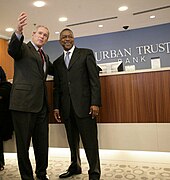
Some activists and academics contend that American news media coverage of African American news, concerns, or dilemmas is inadequate,[279][280][281]or that the news media present distorted images of African Americans.[282]
To combat this,Robert L. Johnsonfounded Black Entertainment Television (BET), a network that targets young African Americans and urban audiences in the United States. Over the years, the network has aired such programming asrapandR&Bmusic videos, urban-oriented movies and television series, and some public affairs programs. On Sunday mornings, BET would broadcast Christian programming; the network would also broadcast non-affiliated Christian programs during the early morning hours daily. According toViacom,BET is now a global network that reaches households in the United States, Caribbean, Canada, and the United Kingdom.[283]The network has gone on to spawn several spin-off channels, includingBET Her(originally launched asBET on Jazz), which originally showcasedjazzmusic-related programming, and later expanded to include general-interest urban programs as well as some R&B,soul,andworld music.[284]
Another network targeting African Americans isTV One.TV One's original programming was formally focused on lifestyle and entertainment-oriented shows, movies, fashion, and music programming. The network also reruns classic series from as far back as the 1970s to current series such asEmpireandSister Circle.TV One is owned byUrban One,founded and controlled byCatherine Hughes.Urban One is one of the nation's largest radio broadcasting companies and the largest African American-owned radio broadcasting company in the United States.[285]
In June 2009,NBC Newslaunched a new website namedTheGrio[286]in partnership with the production team that created the Black documentary filmMeeting David Wilson.It is the first African American videonews sitethat focuses on underrepresented stories in existing national news.The Grioconsists of a broad spectrum of original video packages, news articles, and contributor blogs on topics including breaking news, politics, health, business, entertainment and Black History.[287]
Black-owned and oriented media outlets
- The Africa Channel– Dedicated to programming about African culture.
- aspireTV– a digital cable and satellite channel owned by businessman and former basketball playerMagic Johnson.
- ATTV – an independent public affairs and educational channel.
- BET Media Group– The most prominent multimedia outlet targeting Afro-Americans.
- Bounce TV– a digital multicast network owned by theE. W. Scripps Company.
- Fox Soul– a digital television and streaming network primarily airing original talk shows and syndicated programming
- Oprah Winfrey Network– a cable and satellite network founded byOprah Winfreyand jointly owned byWarner Bros. DiscoveryandHarpo Studios.While not exclusively targeting African Americans, much of its original programming is geared towards a similar demographic.
- Revolt– a music channel and media company founded bySean "Puff Daddy" Combs.
- Soul of the South Network– a regional broadcast network.
- TheGrio- a digital multicast network focused on news and opinion-based programming.
- TV One– a general entertainment network targeting adults.
- Cleo TV– a sister network targetingmillennialandGeneration Xwomen
- We TV– Owned byAMC Networks,became slanted towards Black women during the 2010s
Culture
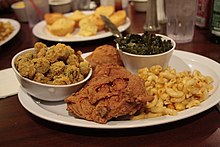
From their earliest presence in North America, African Americans have significantly contributed literature, art, agricultural skills, cuisine, clothing styles, music, language, and social and technological innovation to American culture. The cultivation and use of many agricultural products in the United States, such asyams,peanuts, rice,okra,sorghum,grits,watermelon,indigo dyes,and cotton, can be traced to West African and African American influences. Notable examples includeGeorge Washington Carver,who created nearly 500 products from peanuts, sweet potatoes, and pecans.[289]Soul foodis a variety of cuisine popular among African Americans. It is closely related to thecuisine of the Southern United States.The descriptive terminology may have originated in the mid-1960s, whensoulwas a common definer used to describe African American culture (for example,soul music). African Americans were the first peoples in the United States to make fried chicken, along withScottishimmigrants to the South. Although the Scottish had been frying chicken before they emigrated, they lacked the spices and flavor that African Americans had used when preparing the meal. The Scottish American settlers therefore adopted the African American method of seasoning chicken.[290]However, fried chicken was generally a rare meal in the African American community and was usually reserved for special events or celebrations.[291]
Language
African-American Englishis avariety(dialect,ethnolect,andsociolect) ofAmerican English,commonly spoken by urbanworking-classand largelybi-dialectalmiddle-classAfrican Americans.[292]
African American English evolved during the antebellum period through interaction between speakers of 16th- and 17th-century English of Great Britain and Ireland and various West African languages. As a result, the variety shares parts of itsgrammarandphonologywith theSouthern American Englishdialect. African American English differs from Standard American English (SAE) in certain pronunciation characteristics, tense usage, and grammatical structures, which were derived from West African languages (particularly those belonging to theNiger–Congofamily).[293]
Virtually all habitual speakers of African American English can understand and communicate in Standard American English. As with all linguistic forms, AAVE's usage is influenced by various factors, including geographical, educational and socioeconomic background, as well as formality of setting.[293]Additionally, there are many literary uses of this variety of English, particularly inAfrican American literature.[294]
Traditional names
African-American namesare part of the cultural traditions of African Americans, most of these cultural names having no connection to Africa but strictly an African American cultural practice that developed in the United States during enslavement.[295]This new evidence became apparent by census records which show African Americans and White Americans, though they spoke the same language, chose to use different names even during times of enslavement, which is where and when the development of African American cultural names began.[295]
Prior to this newer information, it was only thought that before the 1950s, and 1960s, most African-American names closely resembled those used within European-American culture.[296]Babies of that era were generally given a few common names, with children using nicknames to distinguish the various people with the same name. With the rise of 1960s civil rights movement, there was a dramatic increase in names of various origins.[297]
By the 1970s, and 1980s, it had become common among African Americans to invent new names for themselves, although many of these invented names took elements from popular existing names. Prefixes such as La/Le, Da/De, Ra/Re and Ja/Je, and suffixes like -ique/iqua, -isha and -aun/-awn are common, as are inventive spellings for common names. The bookBaby Names Now: From Classic to Cool—The Very Last Word on First Namesplaces the origins of "La" names in African-American culture inNew Orleans.[298]
Even with the rise of inventive names, it is still common for African Americans to use biblical, historical, or traditional European names. Daniel, Christopher, Michael, David, James, Joseph, and Matthew were thus among the most frequent names for African-American boys in 2013.[296][299][300]
The name LaKeisha is typically considered American in origin but has elements that were drawn from both French and West/Central African roots. Names such as LaTanisha, JaMarcus, DeAndre, and Shaniqua were created in the same way. Punctuation marks are seen more often within African American names than other American names, such as the names Mo'nique and D'Andre.[296]
Religion
Religious affiliation of African Americans in 2007[301]


The majority of African Americans areProtestant,many of whom follow the historically Black churches.[302]The termBlack churchrefers to churches which minister to predominantly African American congregations. Black congregations were first established by freed slaves at the end of the 17th century, and later when slavery was abolished more African Americans were allowed to create a unique form of Christianity that was culturally influenced by African spiritual traditions.[303]One of these early African American Christian cultural traditions in the Black Church is theWatchnight service,also called Freedom's Eve, where African American congregations all over the nation come together on New Year's Eve through New Years morning in remembrance of the eve and New Year of their emancipation, sharing testimonies, being baptized and partaking in praise and worship.[304]
According to a 2007 survey, more than half of the African American population are part of the historically Black churches.[305]The largest Protestant denomination among African Americans are theBaptists,[306]distributed mainly in four denominations, the largest being theNational Baptist Convention, USAand theNational Baptist Convention of America.[307]The second largest are theMethodists,[308]the largest denominations are theAfrican Methodist Episcopal Churchand theAfrican Methodist Episcopal Zion Church.[307][309]
Pentecostalsare distributed among several different religious bodies, with theChurch of God in Christas the largest among them by far.[307]About 16% of African American Christians are members of White Protestant communions,[308]these denominations (which include theUnited Church of Christ) mostly have a 2 to 3% African American membership.[310]There are also large numbers ofCatholics,constituting 5% of the African American population.[305]Of the total number ofJehovah's Witnesses,22% are Black.[302]
Some African Americans followIslam.Historically, between 15 and 30% of enslaved Africans brought to the Americas wereMuslims,but most of these Africans were converted to Christianity during the era of American slavery.[311]During the twentieth century, some African Americans converted to Islam, mainly through the influence ofBlack nationalistgroups that preached with distinctive Islamic practices; including theMoorish Science Temple of America,and the largest organization, theNation of Islam,founded in the 1930s, which attracted at least 20,000 people by 1963.[312][313]Prominent members included activistMalcolm Xand boxerMuhammad Ali.[314]

Malcolm X is considered the first person to start the movement among African Americans towards mainstream Islam, after he left the Nation and made thepilgrimage to Mecca.[315]In 1975,Warith Deen Mohammed,the son ofElijah Muhammadtook control of the Nation after his father's death and guided the majority of its members toorthodox Islam.[316]
African American Muslimsconstitute 20% of the totalUS Muslim population,[317]the majority areSunnior orthodox Muslims, some of these identify under the community ofW. Deen Mohammed.[318][319]The Nation of Islam led byLouis Farrakhanhas a membership ranging from 20,000 to 50,000 members.[320]
There is also a small but growing group ofAfrican American Jews,making up less than 0.5% of African Americans or about 2% of theJewish population in the United States.The majority of African-American Jews areAshkenazi,while smaller numbers identify asSephardi,Mizrahi,or other.[321][322][323]Many African-American Jews are affiliated with denominations such as theReform,Conservative,Reconstructionist,orOrthodoxbranches of Judaism, but the majority identify as "Jews of no religion", commonly known as secular Jews. A significant number of people who identify themselves as "Black Jews" are affiliated withsyncreticreligious groups, largely theBlack Hebrew Israelites,whose beliefs include the claim that African Americans are descended from the BiblicalIsraelites.[324]Jews of all races typically do not accept Black Hebrew Israelites as Jews, in part because they are usually not Jewishaccording to Jewish law,[325]and in part because these groups are sometimes associated with antisemitism.[326][327]African-American Jews have criticized the Black Hebrew Israelites, regarding the movement as primarily composed of Black non-Jews who have appropriated Black-Jewish identity.[328]
Confirmedatheistsare less than one half of one percent, similar to numbers forHispanics.[329][330][331]
Music
African American musicis one of the most pervasive African American cultural influences in the United States today and is among the most dominant in mainstream popular music.Hip hop,R&B,funk,rock and roll,soul,blues,and other contemporary American musical forms originated in Black communities and evolved from other Black forms of music, includingblues,doo-wop,barbershop,ragtime,bluegrass,jazz,andgospel music.
African American-derived musical forms have also influenced and been incorporated into virtually every otherpopular musicgenre in the world, includingcountryandtechno.African American genres are the most important ethnic vernacular tradition in America, as they have developed independent of African traditions from which they arise more so than any other immigrant groups, including Europeans; make up the broadest and longest lasting range of styles in America; and have, historically, been more influential, interculturally, geographically, and economically, than other American vernacular traditions.[332]
Dance
African Americans have also had an important role in American dance.Bill T. Jones,a prominent modern choreographer and dancer, has included historical African American themes in his work, particularly in the piece "Last Supper at Uncle Tom's Cabin/The Promised Land". Likewise,Alvin Ailey's artistic work, including his "Revelations" based on his experience growing up as an African American in the South during the 1930s, has had a significant influence on modern dance. Another form of dance,stepping,is an African American tradition whose performance and competition has been formalized through the traditionally Black fraternities and sororities at universities.[333]
Literature and academics
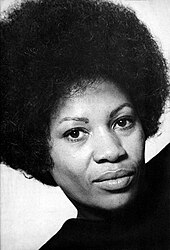
Many African American authors have written stories, poems, and essays influenced by their experiences as African Americans.African American literatureis a major genre in American literature. Famous examples includeLangston Hughes,James Baldwin,Richard Wright,Zora Neale Hurston,Ralph Ellison,Nobel Prize winnerToni Morrison,andMaya Angelou.
African American inventorshave created many widely used devices in the world and have contributed to internationalinnovation.Norbert Rillieuxcreated the technique for converting sugar cane juice into white sugar crystals. Moreover, Rillieux leftLouisianain 1854 and went to France, where he spent ten years working with the Champollions decipheringEgyptian hieroglyphicsfrom theRosetta Stone.[334]Most slave inventors were nameless, such as the slave owned by theConfederatePresidentJefferson Daviswho designed the ship propeller used by the Confederate navy.[335]
By 1913, over 1,000 inventions were patented by Black Americans. Among the most notable inventors wereJan Matzeliger,who developed the first machine to mass-produce shoes,[336]andElijah McCoy,who invented automatic lubrication devices for steam engines.[337]Granville Woodshad 35 patents to improve electric railway systems, including the first system to allow moving trains to communicate.[338]Garrett A. Morgandeveloped the first automatic traffic signal and gas mask.[339]
Lewis Howard Latimerinvented an improvement for the incandescent light bulb.[340]More recent inventors includeFrederick McKinley Jones,who invented the movable refrigeration unit for food transport in trucks and trains.[341]Lloyd Quartermanworked with six other Black scientists on the creation of the atomic bomb (code named theManhattan Project.)[342]Quarterman also helped develop the first nuclear reactor, which was used in the atomically poweredsubmarinecalled the Nautilus.[343]
A few other notable examples include the first successfulopen heart surgery,performed byDaniel Hale Williams,[344]and the air conditioner, patented byFrederick McKinley Jones.[341]Mark Deanholds three of the original nine patents on the computer on which all PCs are based.[345][346][347]More current contributors includeOtis Boykin,whose inventions included several novel methods for manufacturing electrical components that found use in applications such as guided missile systems and computers,[348]and ColonelFrederick Gregory,who was not only the first Blackastronautpilot but the person who redesigned the cockpits for the last three space shuttles. Gregory was also on the team that pioneered the microwave instrumentation landing system.[349]
As part of the preservation of their culture, African Americans have continuously launched their own publications and publishing houses, such asRobert Sengstacke Abbott,founder of the Chicago Defender newspaper, andCarter G. Woodson,the founder ofBlack History Monthwho spent over thirty years documenting and publishing African American history in journals and books. TheJohnson Publishing Company,founded by John H. Johnson in 1942, is a National Historic Landmark.[350]
Terminology
General

The termAfrican Americanwas popularized byJesse Jacksonin the 1980s,[7]although there are recorded uses from the 18th and 19th centuries,[351]for example, in post-emancipation holidays and conferences.[352][353]Earlier terms also used to describe Americans of African ancestry referred more to skin color than to ancestry. Other terms (such ascolored,person of color,ornegro) were included in the wording of various laws and legal decisions which some thought were being used as tools ofWhite supremacyandoppression.[354]

A 16-page pamphlet entitled "A Sermon on the Capture of Lord Cornwallis" is notable for the attribution of itsauthorshipto "AnAfrican American".Published in 1782, the book's use of this phrase predates any other yet identified by more than 50 years.[355]
In the 1980s, the termAfrican Americanwas advanced on the model of, for example,German AmericanorIrish American,to give descendants ofAmerican slaves,and other American Blacks who lived through the slavery era, aheritageand a cultural base.[354]The term was popularized in Black communities around the country viaword of mouthand ultimately received mainstream use afterJesse Jacksonpublicly used the term in front of a national audience in 1988. Subsequently, major media outlets adopted its use.[354]
Surveys in the 1990s and the first decade of the 21st century showed that the majority of Black Americans had no preference forAfrican AmericanversusBlack American,[356]although they had a slight preference for the latter in personal settings and the former in more formal settings.[357]By 2021, according to polling fromGallup,58% of Black Americans expressed no preference for what their group should be called, with 17% each preferringBlackandAfrican-American.Among those with no preference, Gallup found a slight majority favoredBlack"if [they] had to choose."[358]
In 2020, theAssociated Pressupdated itsAP Stylebookto direct its writers to capitalize the first letter ofBlackwhen it is used "in a racial, ethnic or cultural sense, conveying an essential and shared sense of history, identity and community among people who identify as Black, including those in the African diaspora and within Africa."[359]The New York Timesand other outlets made similar changes at the same time, to put "Black" on the same footing as other racial and ethnic terms, such as Latino, Asian, and African-American.[360]
In 2023, the government released a new more detailed breakdown due to the rise in racially Black immigration into the US, listing African American as a compound termed ethnicity, distinguished from other racially Black ethnicities such as Nigerian, Jamaican etc.[361]
The termAfrican Americanembracespan-Africanismas earlier enunciated by prominent African thinkers such asMarcus Garvey,W. E. B. Du Bois,andGeorge Padmore.The termAfro-Usonian,and variations of such, are more rarely used.[362][363]
Official identity

Since 1977, in an attempt to keep up with changing social opinion, theUnited States governmenthas officially classified Black people (revised toBlackorAfrican Americanin 1997) as "having origins in any of the black racial groups of Africa."[364]Other federal offices, such as the US Census Bureau, adhere to theOffice of Management and Budgetstandards on race in their data collection and tabulation efforts.[365]In preparation for the2010 US census,a marketing and outreach plan called2010 Census Integrated Communications Campaign Plan(ICC) recognized and defined African Americans as Black people born in the United States. From the ICC perspective, African Americans are one of three groups of Black people in the United States.[366]
The ICC plan was to reach the three groups by acknowledging that each group has its own sense of community that is based on geography and ethnicity.[367]The best way to market the census process toward any of the three groups is to reach them through their own unique communication channels and not treat the entire Black population of the US as though they are all African Americans with a single ethnic and geographical background. TheFederal Bureau of Investigationof theUS Department of Justicecategorizes Black or African American people as "[a] person having origins in any of the black racial groups of Africa" through racial categories used in the UCR Program adopted from the Statistical Policy Handbook (1978) and published by the Office of Federal Statistical Policy and Standards,US Department of Commerce,derived from the 1977Office of Management and Budgetclassification.[368]
Admixture
Historically, "race mi xing"between Black and White people wastabooin the United States. So-calledanti-miscegenation laws,barring Blacks and Whites frommarryingor having sex, were established incolonial Americaas early as 1691,[369]and endured in manySouthern statesuntil theSupreme Courtruled them unconstitutional inLoving v. Virginia(1967). The taboo among American Whites surrounding White-Black relations is a historical consequence of the oppression andracial segregationof African Americans.[370]HistorianDavid Brion Davisnotes the racial mi xing that occurred during slavery was frequently attributed by theplanter classto the "lower-class white males" but Davis concludes that "there is abundant evidence that many slaveowners, sons of slaveowners, and overseers took black mistresses or in effect raped the wives and daughters of slave families."[371]A famous example wasThomas Jefferson's mistress,Sally Hemings.[372]Although publicly opposed to race mi xing, Jefferson, in hisNotes on the State of Virginiapublished in 1785, wrote: "The improvement of the blacks in body and mind, in the first instance of their mixture with the whites, has been observed by every one, and proves that their inferiority is not the effect merely of their condition of life".[373]
Harvard UniversityhistorianHenry Louis Gates Jr.wrote in 2009 that "African Americans...are a racially mixed ormulattopeople—deeply and overwhelmingly so "(seegenetics). After theEmancipation Proclamation,Chinese Americanmen married African American women in high proportions to their total marriage numbers due to few Chinese American women being in the United States.[374]African slaves and their descendants have also had a history of cultural exchange andintermarriagewith Native Americans,[375]although they did not necessarily retain social, cultural or linguistic ties to Native peoples.[376]There are also increasing intermarriages and offspring between non-Hispanic Blacks and Hispanics of any race, especially betweenPuerto Ricansand African Americans (American-born Blacks).[377]According to author M. M. Drymon, many African Americans identify as havingScots-Irishancestry.[378]
Racially mixed marriages have become increasingly accepted in the United States since the civil rights movement and up to the present day.[379]Approval in national opinion polls has risen from 36% in 1978, to 48% in 1991, 65% in 2002, 77% in 2007.[380]A Gallup poll conducted in 2013 found that 84% of Whites and 96% of Blacks approved of interracial marriage, and 87% overall.[381]
At the end of World War II, some African American military men who had been stationed in Japan marriedJapanese women,who then immigrated to the United States.[382]
Terminology dispute
In her bookThe End of Blackness,as well as in an essay forSalon,[383]authorDebra Dickersonhas argued that the termBlackshould refer strictly to the descendants of Africans who were brought to America as slaves, and not to the sons and daughters of Black immigrants who lack that ancestry. Thus, under her definition, President Barack Obama, who is the son of a Kenyan, is not Black.[383][384]She makes the argument that grouping all people of African descent together regardless of their unique ancestral circumstances would inevitably deny the lingering effects of slavery within the American community of slave descendants, in addition to denying Black immigrants recognition of their own unique ancestral backgrounds. "Lumping us all together", Dickerson wrote, "erases the significance of slavery and continuing racism while giving the appearance of progress."[383]Similar comments have been made concerning Kamala Harris, the daughter of a Caribbean immigrant, who was elected vice president in 2020.[385][386][387]
Similar viewpoints to Dickerson's have been expressed by authorStanley Crouchin aNew York Daily Newspiece,Charles Steele Jr.of theSouthern Christian Leadership Conference[388]and African American columnistDavid Ehrensteinof theLos Angeles Times,who accused White liberals of flocking to Blacks who wereMagic Negros,a term that refers to a Black person with no past who simply appears to assist the mainstream White (as cultural protagonists/drivers) agenda.[389]Ehrenstein went on to say "He's there to assuage white 'guilt' they feel over the role of slavery and racial segregation in American history."[389]
TheAmerican Descendants of Slavery(ADOS) movement coalesces around this view, arguing that Black descendants of American slavery deserve a separate ethnic category that distinguishes them from other Black groups in the United States.[390]Their terminology has gained popularity in some circles, but others have criticized the movement for a perceived bias against (especially poor and Black) immigrants, and for its often inflammatory rhetoric.[385][391][392]Politicians such as Obama and Harris have received especially pointed criticism from the movement, as neither are ADOS and have spoken out at times against policies specific to them.[386][387]
ManyPan-Africanmovements and organizations that are ideologicallyBlack nationalist,anti-imperialist,anti-Zionist,andScientific socialistlike TheAll-African People's Revolutionary Party (A-APRP),have argued thatAfrican(relating to the diaspora) orNew Afrikanshould be used instead of African American.[393]Most notably,Malcolm XandKwame Tureexpressed similar views that African Americans are Africans who "happen to be in America", and should not claim or identify as being American if they are fighting for Black (New Afrikan) liberation. Historically, this is due to the enslavement of Africans during theTrans-Atlantic slave trade,ongoing anti-black violence, and structural racism in countries like the United States.[394][395]
Terms no longer in common use
Before the independence of theThirteen Coloniesuntil the abolition of slavery in 1865, an African American slave was commonly known as anegro.Free negrowas the legal status in the territory of an African American person who was not enslaved.[396]In response to the project of theAmerican Colonization Societyto transport free Blacks to the future Liberia, a project most Blacks strongly rejected, the Blacks at the time said they were no more African than White Americans were European, and referred to themselves with what they considered a more acceptable term, "coloredAmericans ". The term was used until the second quarter of the 20th century, when it was considered outmoded and generally gave way again to the exclusive use ofnegro.By the 1940s, the term was commonly capitalized (Negro); but by the mid-1960s, it was considered disparaging. By the end of the 20th century,negrohad come to be considered inappropriate and was rarely used and perceived as apejorative.[397][398]The term is rarely used by younger Black people, but remained in use by many older African Americans who had grown up with the term, particularly in the Southern US.[399]The term remains in use in some contexts, such as theUnited Negro College Fund,an American philanthropic organization that funds scholarships for Black students and general scholarship funds for 39 private historically Black colleges and universities.
There are many other deliberately insulting terms, many of which were in common use (e.g.,nigger), but had become unacceptable in normal discourse before the end of the 20th century. One exception is the use, among the Black community, of the slurniggerrendered asnigga,representing the pronunciation of the word inAfrican American English.This usage has been popularized by Americanrapandhip-hopmusic culturesand is used as part of anin-grouplexiconand speech. It is not necessarilyderogatoryand, when used among Black people, the word is often used to mean "homie"or" friend ".[400]
Acceptance of intra-group usage of the wordniggais still debated, although it has established a foothold among younger generations. TheNAACPdenounces the use of bothniggaandnigger.[401]Mixed-race usage ofniggais still considered taboo, particularly if the speaker is White. However, trends indicate that usage of the term in intragroup settings is increasing even among White youth due to the popularity of rap and hip hop culture.[402]
See also
- African-American art
- African American cinema
- African-American middle class
- African-American neighborhood
- African-American upper class
- African diaspora in the Americas
- Afrophobia
- AP African American Studies
- Black Belt in the American South
- Black Hispanic and Latino Americans
- Black Ozarkers
- Black Southerners
- Civil rights movement (1865–1896)
- Civil rights movement (1896–1954)
- Juneteenth
- National Museum of African American History and Culture
- North Africans in the United States
- Society and Black people in the Spanish Colonial Americas
- South African Americans
- Stereotypes of African Americans
- Timeline of the civil rights movement
- African immigration to the United States
- West Indian Americans
- African American–Jewish relations
- African American–Korean American relations
Diaspora
Lists
- Index of articles related to African Americans
- List of African-American neighborhoods
- List of majority-Black counties in the United States
- List of African-American newspapers and media outlets
- List of historically black colleges and universities
- List of African-American inventors and scientists
- List of African American poets
- List of African-American astronauts
- List of monuments to African Americans
- List of populated places in the United States with African-American plurality populations
- List of topics related to the African diaspora
- List of African-American holidays
- Lists of African Americans
- List of African-American LGBT people
Notes
- ^Meaning "1% or more"
- ^DNA studies of African-Americans have determined that they primarily descend from variousNiger-Congo-speaking West/Central African ethnic groups:Akan(including theAshantiandFantesubgroups),Balanta,Bamileke,Bamun,Bariba,Biafara,Bran,Chokwe,Dagomba,Edo,Ewe,Fon,Fula,Ga,Gurma,Hausa,Ibibio(including theEfiksubgroup),Igbo,Igala,Ijaw(including theKalabarisubgroup),Itsekiri,Jola,Luchaze,Lunda,Kpele,Kru,Mahi,Mandinka(including theMendesubgroup),Naulu,Serer,Susu,Temne,Tikar,Wolof,Yaka,Yoruba,andBantu peoples;specifically theDuala,Kongo,Luba,Mbundu(including theOvimbundusubgroup) andTeke.[226]
References
- ^abcdefgh"Race and Ethnicity in the United States".United States Census Bureau.August 12, 2021.RetrievedAugust 17,2021.
- ^"Religious tradition by race/ethnicity (2014)".The Pew Forum on Religion & Public Life.Archivedfrom the original on May 18, 2015.RetrievedApril 5,2019.
- ^"The Black Population: 2010" (PDF),Census Bureau, September 2011. "Black or African Americans" refers to a person having origins in any of the Black racial groups of Africa. The Black racial category includes people who marked the "Black, African Am., or Negro" checkbox. It also includes respondents who reported entries such as African American; Sub-Saharan African entries, such as Kenyan and Nigerian; and Afro-Caribbean entries, such as Haitian and Jamaican. "
- ^African Americans Law & Legal DefinitionArchivedAugust 17, 2018, at theWayback Machine:"African Americans are citizens or residents of the United States who have origins in any of the black populations of Africa. In the United States, the terms are generally used for Americans with at least partial Sub-Saharan African ancestry."
- ^"Measuring Racial and Ethnic Diversity for the 2020 Census".The United States Census Bureau.Archivedfrom the original on April 30, 2023.RetrievedApril 23,2023.
- ^Locke, Don C.; Bailey, Deryl F. (2013).Increasing Multicultural Understanding.SAGE Publications. p. 106.ISBN978-1483314211.Archivedfrom the original on August 18, 2018.RetrievedMarch 7,2018.
African American refers to descendants of enslaved Black people who are from the United States. The reason we use an entire continent (Africa) instead of a country (e.g., Irish American) is because slave masters purposefully obliterated tribal ancestry, language, and family units in order to destroy the spirit of the people they enslaved, thereby making it impossible for their descendants to trace their history prior to being born into slavery.
- ^abWilkerson, Isabel (January 31, 1989)."'African-American' Favored By Many of America's Blacks ".The New York Times.ISSN0362-4331.RetrievedDecember 28,2020.
A movement led by the Rev. Jesse Jackson to call blacks African-Americans has met with both rousing approval and deep-seated skepticism in a debate that is coming to symbolize the role and history of blacks in this country.... The question of a name has caused pain and controversy since the first Africans were captured and shipped to the Americas in the 17th century. The slaves called themselves Africans at first, but slave masters gave them English names and called them Negroes, the Portuguese word for black, historians say. That term was resented by some blacks who said it was degrading when whites mispronounced it, accidentally or intentionally.
- ^Gomez, Michael A:Exchanging Our Country Marks: The Transformation of African Identities in the Colonial and Antebellum South,p. 29. Chapel Hill, NC: University of North Carolina, 1998.
- ^Rucker, Walter C. (2006).The River Flows On: Black resistance, culture, and identity formation in early America.LSU Press. p. 126.ISBN978-0-8071-3109-1.
- ^Forson, Tracy Scott (February 21, 2018)."Who is an 'African American'? Definition evolves as USA does".USA Today.Archivedfrom the original on May 16, 2023.RetrievedMay 14,2023.
- ^United States Census Bureau."What Updates to OMB's Race/Ethnicity Standards Mean for the Census Bureau".Census.gov.RetrievedJune 29,2024.
- ^abGates, Henry Louis Jr(2009).In Search of Our Roots: How 19 Extraordinary African Americans Reclaimed Their Past.New York: Crown Publishing. pp. 20–21.
- ^Harris, Paul (October 8, 2015)."How the end of slavery led to starvation and death for millions of black Americans".The Guardian.Archivedfrom the original on January 16, 2023.
- ^"One-in-Ten Black People Living in the U.S. Are Immigrants | Immigration Research Library".immigrationresearch.org.RetrievedJuly 4,2024.
- ^MacAskill, Ewen; Goldenberg, Suzanne; Schor, Elana (November 5, 2008)."Barack Obama to be America's first black president".The Guardian.ISSN0261-3077.Archivedfrom the original on March 1, 2016.RetrievedFebruary 19,2016.
- ^Eaglin, Maya (February 21, 2021)."The soundtrack of history: How Black music has shaped American culture through time".NBC News.Archivedfrom the original on April 19, 2022.RetrievedApril 14,2022.
- ^Osei, Sarah (November 4, 2020)."How Black People Created All Your Favorite Music".Highsnobiety.RetrievedApril 14,2022.
- ^"The transatlantic slave trade".BBC.Archivedfrom the original on May 6, 2021.RetrievedMay 6,2021.
- ^"Implications of the slave trade for African societies".London:BBC.Archivedfrom the original on June 9, 2020.RetrievedJune 12,2020.
- ^"The capture and sale of slaves".Liverpool:International Slavery Museum.Archivedfrom the original on December 29, 2019.RetrievedOctober 14,2015.
- ^abRobert Wright, Richard(1941). "Negro Companions of the Spanish Explorers".Phylon.2(4).
- ^J. Michael Francis, PhD,Luisa de Abrego: Marriage, Bigamy, and the Spanish Inquisition,University of South Florida, archived fromthe originalon July 21, 2018,retrievedJuly 21,2018
- ^Grizzard, Frank E. Jr.;Smith, D. Boyd (2007).Jamestown Colony: A Political, Social, and Cultural History.Santa Barbara, Calif.: ABC-CLIO. p. 198.ISBN978-1-85109-637-4.
- ^Wood, Betty (1997). "Tobacco Slaves: The Chesapeake Colonies".The Origins of American Slavery: Freedom and Bondage in the English Colonies.New York: Hill and Wang. pp. 68–93.ISBN978-0-8090-1608-2.
- ^Hashaw, Tim (January 21, 2007)."The First Black Americans".U.S. News & World Report.Archived fromthe originalon February 2, 2011.RetrievedFebruary 13,2008.
- ^"The shaping of Black America: forthcoming 400th celebration".Encyclopedia.June 26, 2006. Archived fromthe originalon March 5, 2008.RetrievedJanuary 20,2011.
- ^"The First Black Americans – U.S. News & World Report".Usnews. January 29, 2007. Archived fromthe originalon February 2, 2011.RetrievedJanuary 20,2011.
- ^"New Netherland Institute:: Slave Trade".newnetherlandinstitute.org.New Netherland Institute.Archivedfrom the original on July 8, 2019.RetrievedJuly 8,2019.
- ^Jordan, Winthrop (1968).White Over Black: American attitudes Toward the Negro, 1550–1812.University of North Carolina Press.ISBN978-0807871416.
- ^Higginbotham, A. Leon (1975).In the Matter of Color: Race and the American Legal Process: The Colonial Period.Greenwood Press.ISBN9780195027457.
- ^Gene Allen Smith, Texas Christian University,Sanctuary in the Spanish Empire: An African American officer earns freedom in Florida,National Park Service,archivedfrom the original on January 10, 2021,retrievedApril 5,2018
- ^John Henderson Russell,The Free Negro In Virginia, 1619–1865,Baltimore: Johns Hopkins Press, 1913, pp. 29–30, scanned text online.
- ^Sweet, Frank W. (July 2005).Legal History of the Color Line: The Rise and Triumph of the One-Drop Rule.Backintyme. p. 117.ISBN978-0-939479-23-8.Archivedfrom the original on January 7, 2024.RetrievedJune 16,2015.
- ^Hodges, Russel Graham (1999),Root and Branch: African Americans in New York and East Jersey, 1613–1863,Chapel Hill, North Carolina: University of North Carolina Press
- ^Taunya Lovell Banks, "Dangerous Woman: Elizabeth Key's Freedom Suit – Subjecthood and Racialized Identity in Seventeenth Century Colonial Virginia"ArchivedOctober 24, 2019, at theWayback Machine,41Akron Law Review799 (2008), Digital Commons Law, University of Maryland Law School. Retrieved April 21, 2009
- ^PBS.Africans in America: the Terrible Transformation."From Indentured Servitude to Racial SlaveryArchivedJune 4, 2007, at theWayback Machine."Accessed September 13, 2011.
- ^William J. Wood, "The Illegal Beginning of American Slavery"ArchivedJanuary 7, 2024, at theWayback Machine,ABA Journal,1970, American Bar Association
- ^Russell, John H. (June 1916)."Colored Freemen as Slave Owners in Virginia".Journal of Negro History.1(3): 233–242.doi:10.2307/3035621.ISSN0022-2992.JSTOR3035621.
- ^ab"RUNAWAY! How George Washington, Other Slave Owners Used Newspapers to Hunt Escaped Slaves".Library of Congress.Archivedfrom the original on August 30, 2022.RetrievedAugust 30,2022.
- ^ab"Fugitive Slave Laws".Encyclopedia Virginia.Archivedfrom the original on February 18, 2022.RetrievedFebruary 18,2022.
- ^Berquist, Emily (June 2010). "Early Anti-Slavery Sentiment in the Spanish Atlantic World, 1765–1817".Slavery & Abolition.31(2): 181–205.doi:10.1080/01440391003711073.S2CID145434799.
- ^abSlavery in Spanish Colonial Louisiana,knowlouisiana.org, archived fromthe originalon July 21, 2018,retrievedJuly 21,2018
- ^ab"Slave Patrols: An Early Form of American Policing".National Law Enforcement Museum.July 10, 2019. Archived fromthe originalon June 9, 2020.RetrievedJune 16,2020.
- ^"Scots to Colonial North Carolina Before 1775".Dalhousielodge.org. n.d. Archived fromthe originalon February 19, 2012.RetrievedApril 20,2012.
- ^"African Americans in the American Revolution".Wsu.edu:8080. June 6, 1999. Archived fromthe originalon May 14, 2011.RetrievedJanuary 20,2011.
- ^Benjamin Quarles,The Negro in the American revolution(1961).
- ^Gary B. Nash, "The African Americans' Revolution" inThe Oxford Handbook of the American Revolutioned. by Jane Kamensky and Edward G. Gray (2012) online atdoi:10.1093/oxfordhb/9780199746705.013.0015
- ^Braidwood, Stephen (1994).Black Poor and White Philanthropists: London's Blacks and the Foundation of the Sierra Leone Settlement, 1786–1791.Liverpool University Press.ISBN978-0-85323-377-0.
- ^Finkelman, Paul (2012)."Slavery in the United States: Persons or Property?".In Allain, Jean (ed.).The Legal Understanding of Slavery: From the Historical to the Contemporary.Oxford University Press. pp. 105–134 [116].doi:10.1093/acprof:oso/9780199660469.003.0007.ISBN978-0-19-174550-8.Archivedfrom the original on April 18, 2023.RetrievedApril 18,2023.
- ^Walker, James W. (1992). "Chapter Five: Foundation of Sierra Leone".The Black Loyalists: The Search for a Promised Land in Nova Scotia and Sierra Leone, 1783–1870.Toronto: University of Toronto Press. pp.94–114.ISBN978-0-8020-7402-7.Originally published by Longman & Dalhousie University Press (1976).
- ^Finkelman, Paul (2007)."The Abolition of The Slave Trade".New York Public Library. Archived fromthe originalon October 9, 2018.RetrievedAugust 30,2021.
- ^Calore, Paul (2008).The Causes of the Civil War: The Political, Cultural, Economic and Territorial Disputes between North and South.McFarland. p. 10.
- ^abc"Background on conflict in Liberia",Friends Committee on National Legislation, July 30, 2003ArchivedFebruary 14, 2007, at theWayback Machine
- ^Gomez, Edmund Terence; Premdas, Ralph.Affirmative Action, Ethnicity and Conflict.Routledge. p. 48.ISBN978-0-415-64506-5.Archivedfrom the original on January 7, 2024.RetrievedSeptember 26,2015.
- ^Maggie Montesinos Sale (1997).The Slumbering Volcano: American Slave Ship Revolts and the Production of Rebellious Masculinity,Duke University Press, 1997, p. 264.ISBN0-8223-1992-6
- ^"Ending slavery in the District of ColumbiaArchivedNovember 19, 2018, at theWayback Machine",consulted June 20, 2015.
- ^abMarcyliena H. Morgan (2002).Language, Discourse and Power in African American CultureArchivedJanuary 7, 2024, at theWayback Machine,p. 20. Cambridge University Press, 2002.
- ^Berlin,Generations of Captivity,pp. 161–162.
- ^Paulson Gage, Joan (August 5, 2013)."Icons of Cruelty".The New York Times.Archivedfrom the original on August 23, 2013.RetrievedFebruary 16,2022.
- ^abTaylor, Nikki M.Frontiers of Freedom: Cincinnati's Black Community, 1802–1868.Ohio University Press, 2005,ISBN0-8214-1579-4,pp. 50–79.
- ^"The Emancipation Proclamation".Featured Documents.National Archives and Records Administration.Archivedfrom the original on June 7, 2007.RetrievedJune 7,2007.
- ^"History of Juneteenth".Juneteenth. 2005. Archived fromthe originalon May 27, 2007.RetrievedJune 7,2007.
- ^Seward certificateArchivedJuly 21, 2018, at theWayback Machineproclaiming the Thirteenth Amendment to have been adopted as part of the Constitution as of December 6, 1865.
- ^Schultz, Jeffrey D. (2002).Encyclopedia of Minorities in American Politics: African Americans and Asian Americans.Oryx Press. p. 284.ISBN9781573561488.Archivedfrom the original on February 4, 2023.RetrievedOctober 8,2015.
- ^abLeland T. Saito (1998). "Race and Politics: Asian Americans, Latinos, and Whites in a Los Angeles Suburb". p. 154. University of Illinois Press
- ^"Black voting rights, 15th Amendment still challenged after 150 years".USA Today.Archivedfrom the original on April 25, 2020.RetrievedNovember 19,2020.
- ^Davis, Ronald L.F."Creating Jim Crow: In-Depth Essay".The History of Jim Crow.New York Life Insurance Company.Archived fromthe originalon June 14, 2002.RetrievedJune 7,2007.
- ^abLeon Litwack,Jim Crow Blues,Magazine of History (OAH Publications, 2004)
- ^Davis, Ronald."Surviving Jim Crow".The History of Jim Crow.New York Life Insurance Company.Archived fromthe originalon May 26, 2012.
- ^Plessy v. Ferguson163U.S.537(1896)
- ^Moyers, Bill."Legacy of Lynching"ArchivedAugust 29, 2017, at theWayback Machine.PBS. Retrieved July 28, 2016.
- ^"The Great Migration".African American World.PBS.2002. Archived fromthe originalon October 12, 2007.RetrievedOctober 22,2007.
- ^Michael O. Emerson, Christian Smith (2001). "Divided by Faith: Evangelical Religion and the Problem of Race in America". p. 42. Oxford University Press
- ^Matthew, Anderson (1900)."The Economic Aspect of the Negro Problem".In Browne, Hugh; Kruse, Edwina; Walker, Thomas C.;Moton, Robert Russa;Wheelock, Frederick D. (eds.).Annual Report of the Hampton Negro Conference.Hampton bulletinno. 9–10, 12–16. Vol. 4.Hampton, Virginia:Hampton Institute Press. p. 39.hdl:2027/chi.14025588.Archivedfrom the original on January 7, 2024.RetrievedNovember 19,2020.
- ^Tolnay, Stewart (2003). "The African American 'Great Migration' and Beyond".Annual Review of Sociology.29:218–221.doi:10.1146/annurev.soc.29.010202.100009.JSTOR30036966.
- ^Seligman, Amanda (2005).Block by block: neighborhoods and public policy on Chicago's West Side.Chicago: University of Chicago Press. pp. 213–14.ISBN978-0-226-74663-0.
- ^Ella Fitzgerald.Holloway House Publishing. 1989. p. 27.
- ^Tolnay, Stewart (2003). "The African American 'Great Migration' and Beyond".Annual Review of Sociology.29:217.doi:10.1146/annurev.soc.29.010202.100009.JSTOR30036966.
- ^Wilkerson, Isabel (September 2016)."The Long-Lasting Legacy of the Great Migration".Smithsonian Magazine.Archivedfrom the original on February 15, 2020.RetrievedNovember 19,2019.
- ^abNewkirk II, Vann R."How 'The Blood of Emmett Till' Still Stains America Today".The Atlantic.Archivedfrom the original on July 28, 2017.RetrievedJuly 29,2017.
- ^Whitfield, Stephen (1991). A Death in the Delta: The story of Emmett Till. pp 41–42. JHU Press.
- ^Haas, Jeffrey (2011).The Assassination of Fred Hampton.Chicago: Chicago Review Press. p. 17.ISBN978-1569767092.
- ^"History of Federal Voting Rights Laws: The Voting Rights Act of 1965".United States Department of Justice. August 6, 2015.Archivedfrom the original on January 6, 2021.RetrievedAugust 12,2017.
- ^"The March On Washington, 1963".Abbeville Press. Archived fromthe originalon October 12, 2007.RetrievedOctober 22,2007.
- ^abThe Unfinished Journey: America Since World War II by William H. Chafe
- ^Jordan, John H. (2013),Black Americans 17th Century to 21st Century: Black Struggles and Successes,Trafford Publishing,p. 3
- ^Roberts, Sam (February 21, 2005)."More Africans Enter U.S. Than in Days of Slavery".The New York Times.Archivedfrom the original on September 12, 2005.RetrievedOctober 26,2014.
- ^ab"Exit polls: Obama wins big among young, minority voters".CNN. November 4, 2008.Archivedfrom the original on August 10, 2010.RetrievedJune 22,2010.
- ^abKuhn, David Paul (November 5, 2008)."Exit polls: How Obama won".Politico.Archivedfrom the original on March 26, 2010.RetrievedJune 22,2010.
- ^ab"Exit polls".The New York Times.2008.Archivedfrom the original on August 16, 2012.RetrievedSeptember 6,2012.
- ^Noah, Timothy (November 10, 2008)."What We Didn't Overcome".Slate.Archivedfrom the original on January 24, 2011.RetrievedJanuary 20,2011.
- ^Barnes, Robert (November 6, 2012)."Obama wins a second term as U.S. president".The Washington Post.Archivedfrom the original on April 17, 2015.RetrievedAugust 12,2017.
- ^Blood, Michael R.; Riccardi, Nicholas (December 5, 2020)."Biden officially secures enough electors to become president".Associated Press.Archivedfrom the original on December 8, 2020.RetrievedMarch 2,2021.
- ^"President Biden Signs the Juneteenth National Independence Day Act Into Law".YouTube.June 17, 2021.Archivedfrom the original on December 11, 2021.
- ^"We the Americans: Blacks"(PDF).US Bureau of Census.Archived(PDF)from the original on October 9, 2022.RetrievedMay 3,2019.
- ^Time: Almanac 2005.Time Incorporated Home Entertainment. December 7, 2004. p.377.ISBN9781932994414.
- ^This table gives the African American population in the United States over time, based on US census figures. (Numbers from years 1920 to 2000 are based on US census figures as given by theTime Almanacof 2005, p. 377.)
- ^"Time Line of African American History, 1881–1900".Lcweb2.loc.gov. n.d.Archivedfrom the original on May 19, 2012.RetrievedApril 20,2012.
- ^American FactFinder, United States Census Bureau."United States – QT-P4. Race, Combinations of Two Races, and Not Hispanic or Latino: 2000".Archived fromthe originalon June 6, 2011.RetrievedJanuary 20,2011.
- ^"c2kbr01-2.qxd"(PDF).Archived fromthe original(PDF)on September 20, 2004.RetrievedJanuary 20,2011.
- ^Kimiko de Freytas-Tamura (January 13, 2023)."African and Invisible: The Other New York Migrant Crisis".The New York Times.Archivedfrom the original on January 25, 2023.RetrievedJanuary 26,2023.
- ^ab"Total Ancestry Reported",American FactFinder.
- ^"The Hispanic Population: 2010"ArchivedJanuary 27, 2018, at theWayback Machine,2010 Census Briefs. U.S. Census Bureau, May 2011.
- ^"American FactFinder – Results".factfinder2.census.gov.Archived fromthe originalon February 12, 2020.
- ^"2010 Census Planning Memoranda Series"(PDF).United States Census Bureau.Archived(PDF)from the original on October 9, 2022.RetrievedNovember 3,2014.
- ^"New Population Counts for 62 Detailed Black or African American Groups".
- ^"African Americans in the 2020 Census".Leadership Conference on Civil and Human Rights.Archivedfrom the original on July 30, 2022.RetrievedJuly 30,2022.
- ^Glaeser, Edward (February 15, 2001)."Census Sampling is Dangerous".Brookings Institution.Archivedfrom the original on July 30, 2022.RetrievedJuly 30,2022.
- ^Benson, Samuel (March 10, 2022)."Census undercounted Black people, Hispanics and Native Americans in 2020".Politico.Archivedfrom the original on July 30, 2022.RetrievedJuly 30,2022.
- ^Lopez, Mark Hugo; Moslimani, Mohamad (February 10, 2023)."Key facts about the nation's 47.2 million Black Americans".Pew Research Center.Archivedfrom the original on July 27, 2023.RetrievedJuly 27,2023.
- ^abGreg Toppo and Paul Overberg,"After nearly 100 years, Great Migration begins reversal"ArchivedFebruary 16, 2021, at theWayback Machine,USA Today,Feb 2, 2015.
- ^O'Hare, By Peggy (August 13, 2021)."Latinos, Blacks Show Strong Growth in San Antonio as White Population Declines".San Antonio Express-News.Archivedfrom the original on March 1, 2023.RetrievedJanuary 3,2024.
- ^Felton Emmanuel (January 2022).
- ^Closson, Troy; Hong, Nicole (January 31, 2023)."Why Black Families Are Leaving New York, and What It Means for the City".The New York Times.ISSN0362-4331.Archivedfrom the original on October 28, 2023.RetrievedOctober 21,2023.
- ^"Top Metropolitan Areas In The USA, By African American Population".National Media Spots.2020.Archivedfrom the original on October 21, 2023.RetrievedOctober 20,2023.
- ^"10 of the Richest Black Communities in America"ArchivedAugust 1, 2018, at theWayback Machine,Atlanta Black Star,January 3, 2014.
- ^"Charles County Surpasses Prince George's as Wealthiest Black County in US: Post".July 8, 2022.Archivedfrom the original on January 7, 2023.RetrievedJanuary 7,2023.
- ^ab"Black Incomes Surpass Whites in Queens".The New York Times.October 1, 2006.Archivedfrom the original on October 25, 2006.RetrievedJuly 18,2016.
- ^"Video Gallery – U.S. Representative Scott Rigell".Archived fromthe originalon August 21, 2016.RetrievedJuly 18,2016.
- ^"Seatack Community Celebrates 200+ Years With Banquet".[permanent dead link]
- ^Jay, William(1835).An Inquiry Into the Character and Tendency of the American Colonization, and American Anti-slavery Societies(2nd ed.). New York:Leavitt, Lord & Co.
- ^Fultz, Michael (February 2021)."Determination and Persistence: Building the African American Teacher Corps through Summer and Intermittent Teaching, 1860s–1890s".History of Education Quarterly.61(1): 4–34.doi:10.1017/heq.2020.65.
- ^Anderson, James D. (1988).The Education of Blacks in the South, 1860–1935.Chapel Hill, NC: University of North Carolina Press.ISBN0-8078-1793-7.
- ^Span, Christopher M. (2009).From Cotton Field to Schoolhouse: African American Education in Mississippi, 1862–1875.Chapel Hill, NC: University of North Carolina Press.
- ^Ladson-Billings, Gloria; Anderson, James D. (February 3, 2021)."Policy Dialogue: Black Teachers of the Past, Present, and Future".History of Education Quarterly.61(1): 94–102.doi:10.1017/heq.2020.68.
- ^Field, Sherry (1995). "Intercultural Education and Negro History during the Second World War".Journal of Midwest History of Education Society.22:75–85.
- ^Dennis, Ashley D. (May 2022). ""The Intellectual Emancipation of the Negro": Madeline Morgan and the Mandatory Black History Curriculum in Chicago during World War II ".History of Education Quarterly.62(2): 136–160.doi:10.1017/heq.2022.2.S2CID248406635.
- ^Kozol, J."Overcoming Apartheid",The Nation.December 19, 2005. p. 26ArchivedMarch 25, 2013, at theWayback Machine
- ^Hannah-Jones, Nikole (April 16, 2014)."Segregation Now".ProPublica.Archivedfrom the original on December 13, 2015.RetrievedDecember 14,2015.
- ^Public Information Office, United States Census Bureau.High School Completions at All-Time High, Census Bureau ReportsArchivedMarch 27, 2010, at theWayback Machine.September 15, 2000.
- ^"California".Closing the Achievement Gap. January 22, 2008. Archived fromthe originalon April 28, 2012.RetrievedApril 20,2012.
- ^Michael A. Fletcher,"Minorities and whites follow unequal college paths, report says"ArchivedDecember 23, 2015, at theWayback Machine,The Washington Post,July 31, 2013.
- ^"Black women become most educated group in US".June 3, 2016.Archivedfrom the original on June 4, 2016.RetrievedJuly 18,2016.
- ^"CPS October 2011 – Detailed Tables".Archived fromthe originalon January 18, 2017.RetrievedDecember 10,2017.
- ^Allie Bidwell,"Racial Gaps in High School Graduation Rates Are Closing"ArchivedJuly 6, 2017, at theWayback Machine,U.S. News,March 16, 2015.
- ^Alonso, Andres A."Black Male Graduation Rates".blackboysreport.org.The Schott Foundation for Public Education. Archived fromthe originalon October 16, 2014.RetrievedSeptember 24,2014.
- ^abRyan, Camille L."Educational Attainment in the United States"(PDF).census.gov.The United States Bureau Of Statistics.Archived(PDF)from the original on October 9, 2022.RetrievedJuly 22,2017.
- ^"African Diaspora Advanced Placement Course, Co-developed by Teachers College, Highlighted by Time".columbia.edu.Columbia University.Archivedfrom the original on July 7, 2022.RetrievedJuly 7,2022.
- ^Gleibermann, Erik."New College Board curriculum puts the African diaspora in the spotlight".The Washington Post.Archivedfrom the original on January 28, 2023.RetrievedJuly 7,2022.
- ^Waters, Brandi (February 2022).Teacher Information Guide AP African American Studies Pilot.Washington, DC: College Board.
- ^"Lists of Historical Black Colleges and Universities"ArchivedJuly 2, 2017, at theWayback Machine,The Network Journal.
- ^"TECH-Levers: FAQs About HBCUs".Archivedfrom the original on August 27, 2016.RetrievedJuly 18,2016.
- ^"The story of historically black colleges in the US – BBC News".BBC News.February 15, 2019.Archivedfrom the original on January 2, 2022.RetrievedJanuary 10,2022.
- ^Parry, Marc (September 30, 2019)."Despite Obstacles, Black Colleges Are Pipelines to the Middle Class, Study Finds. Here's Its List of the Best".The Chronicle of Higher Education.Archivedfrom the original on January 2, 2022.RetrievedJanuary 2,2022.
- ^"Why the racial wealth gap persists, more than 150 years after emancipation".The Washington Post.RetrievedJanuary 25,2024.
- ^Creamer, John (September 15, 2020)."Inequalities Persist Despite Decline in Poverty For All Major Race and Hispanic Origin Groups".Census.gov.Archivedfrom the original on September 17, 2020.RetrievedJuly 13,2021.
- ^Barbarin, Oscar."Characteristics of African American Families"(PDF).University of North Carolina. Archived fromthe original(PDF)on September 20, 2006.RetrievedSeptember 23,2006.
- ^Juliet E.K. Walker, The History of Black Business in America: Capitalism, Race, Entrepreneurship (New York: Macmillan Library Reference, 1998)
- ^DeNavas-Walt, Carmen; Proctor, Bernadette D.; Smith, Jessica C. (September 2012)."Real Median Household Income by Race and Hispanic Origin: 1967 to 2010"(PDF).Income, Poverty, and Health Insurance Coverage in the United States: 2011.United States Census Bureau. p. 8.Archived(PDF)from the original on October 9, 2022.
- ^Minority Groups Increasing Business Ownership at Higher Rate than National Average, Census Bureau ReportsU.S. Census Press Release
- ^abTozzi, John (July 16, 2010)."Minority Businesses Multiply But Still Lag Whites".Bloomberg BusinessWeek.Archived fromthe originalon July 19, 2010.RetrievedApril 20,2012.
- ^Fronczek, Peter; Johnson, Patricia (August 2003)."Occupations: 2000"(PDF).United States Census Bureau.Archived(PDF)from the original on October 9, 2022.RetrievedOctober 24,2006.
- ^abcMcKinnon, Jesse (April 2003)."The Black Population in the United States: March 2002"(PDF).United States Census Bureau.Archived(PDF)from the original on October 9, 2022.RetrievedOctober 24,2006.
- ^abc"PINC-03-Part 131".Pubdb3.census.gov. August 29, 2006. Archived fromthe originalon May 15, 2011.RetrievedJanuary 20,2011.
- ^ab"PINC-03-Part 254".Pubdb3.census.gov. August 29, 2006. Archived fromthe originalon May 9, 2011.RetrievedJanuary 20,2011.
- ^ab"PINC-03-Part 259".Pubdb3.census.gov. August 29, 2006. Archived fromthe originalon May 11, 2011.RetrievedJanuary 20,2011.
- ^ab"PINC-03-Part 135".Pubdb3.census.gov. August 29, 2006. Archived fromthe originalon May 9, 2011.RetrievedJanuary 20,2011.
- ^"PINC-03-Part 253".Pubdb3.census.gov. August 29, 2006. Archived fromthe originalon May 9, 2011.RetrievedJanuary 20,2011.
- ^"PINC-03-Part 128".Pubdb3.census.gov. August 29, 2006. Archived fromthe originalon May 9, 2011.RetrievedJanuary 20,2011.
- ^"PINC-03-Part 133".Pubdb3.census.gov. August 29, 2006. Archived fromthe originalon May 11, 2011.RetrievedJanuary 20,2011.
- ^"PINC-03-Part 5".Pubdb3.census.gov. August 29, 2006. Archived fromthe originalon May 9, 2011.RetrievedJanuary 20,2011.
- ^abcd""Black Workers and the Public Sector", Dr Steven Pitts, University of California, Berkeley, Center for Labor Research and Education, April 4, 2011 "(PDF).Archived fromthe original(PDF)on July 13, 2014.RetrievedJuly 21,2018.
- ^"BLS.gov".BLS.gov. January 7, 2011. Archived fromthe originalon December 13, 2010.RetrievedJanuary 20,2011.
- ^"BLS.gov".Data.bls.gov. Archived fromthe originalon January 20, 2011.RetrievedJanuary 20,2011.
- ^"OMHRC.gov".OMHRC.gov. October 21, 2009. Archived fromthe originalon August 13, 2009.RetrievedJanuary 20,2011.
- ^White, Gillian B. (December 21, 2015)."Education Gaps Don't Fully Explain Why Black Unemployment Is So High".The Atlantic.Archivedfrom the original on May 22, 2021.RetrievedJuly 3,2016.
- ^Riley, Jason. L. (November 4, 2012)."For blacks, the Pyrrhic Victory of the Obama Era".The Wall Street Journal.Archivedfrom the original on December 14, 2022.RetrievedDecember 14,2022.
- ^Ammunition for poverty pimpsArchivedMay 25, 2017, at theWayback MachineWalter E. Williams, October 27, 2005.
- ^"Voting and Registration in the Election of November 2007"(PDF).March 2006.Archived(PDF)from the original on October 9, 2022.RetrievedMay 30,2007.
- ^Mott, Jonathan D. (February 4, 2010)."The United States Congress Quick Facts".ThisNation. Archived fromthe originalon March 5, 2011.RetrievedJanuary 20,2011.
- ^"US Census Bureau, homeownership by race".Archived fromthe originalon March 27, 2010.RetrievedOctober 6,2006.
- ^"Black Families Fall Further Behind on Homeownership".October 13, 2022.Archivedfrom the original on March 8, 2023.RetrievedMarch 8,2023.
- ^"RESIDENTIAL VACANCIES AND HOMEOWNERSHIP"(PDF).Census.gov.Archived(PDF)from the original on October 9, 2022.RetrievedJuly 13,2021.
- ^Wake, John."The Shocking Truth 50 Years After The 1968 Fair Housing Act: The Black Homeownership Paradox".Forbes.Archivedfrom the original on March 8, 2023.RetrievedMarch 8,2023.
- ^"Black homeownership rate rises, but hasn't returned to 2004 level".June 11, 2024. Archived fromthe originalon June 17, 2024.RetrievedJune 17,2024.
- ^"Student Loan Debt A Barrier To Black Homeownership – NMP".Archivedfrom the original on March 8, 2023.RetrievedMarch 8,2023.
- ^Choi, Jung Hyun; Goodman, Laurie (February 27, 2020)."Why do Black College Graduates Have a Lower Homeownership Rate Than White People Who Dropped Out of High School?".Urban Institute.Archivedfrom the original on May 28, 2023.RetrievedMay 28,2023.
- ^Kerubo, Jacquelynn (August 17, 2021)."What Gentrification Means for Black Homeowners".The New York Times.Archivedfrom the original on March 8, 2023.RetrievedMarch 8,2023– via NYTimes.
- ^Beals, Monique (May 5, 2022)."Rising home prices: a timeline".The Hill.Archivedfrom the original on March 8, 2023.RetrievedMarch 16,2023.
- ^"Average annual real wages U.S. 2021".Statista.Archivedfrom the original on March 8, 2023.RetrievedMarch 8,2023.
- ^"South Carolina leads the U.S. in Black homeownership, but there are still a few gaps to close".South Carolina Public Radio.February 22, 2023.Archivedfrom the original on October 18, 2023.RetrievedOctober 16,2023.
- ^Bahney, Anna (March 2, 2023)."The gulf between Black homeowners and White is actually getting bigger, not smaller | CNN Business".CNN.Archivedfrom the original on October 18, 2023.RetrievedOctober 16,2023.
- ^Staff, N. P. R. (May 21, 2021)."Understanding The 2020 Electorate: AP VoteCast Survey".NPR.Archivedfrom the original on February 19, 2021.RetrievedNovember 4,2022.
- ^Dickson, David A. (1996). "American Society and the African American Foreign Policy Lobby: Constraints and Opportunities".Journal of Black Studies.27(2): 139–151.doi:10.1177/002193479602700201.S2CID143314945.
- ^Green, John Clifford; Coffey, Daniel J. (2007).The State of the Parties: The Changing Role of Contemporary American Politics.Rowman & Littlefield. p. 29.ISBN978-0-7425-5322-4.Archivedfrom the original on January 7, 2024.RetrievedJune 16,2015.
- ^Jackson, Jabar; Martin, Jill (July 3, 2020)."NFL plans to play Black national anthem before Week 1 games".CNN.Archivedfrom the original on May 27, 2022.RetrievedJuly 4,2020.
- ^"Till Victory Is Won: The Staying Power Of 'Lift Every Voice And Sing'".NPR.org.Archivedfrom the original on May 31, 2022.RetrievedFebruary 22,2022.
- ^ab"In US, More Adults Identifying as LGBT".Gallup.January 11, 2017.Archivedfrom the original on May 1, 2021.RetrievedJuly 21,2018.
- ^"Blacks Are More Likely to Identify as Gay Than Any Other Group".The Washington Informer.October 23, 2012.
- ^abcde""Life expectancy gap narrows between blacks, whites", Rosie Mestel,The Los Angeles Times,June 5, 2012 ".Los Angeles Times.June 5, 2012.Archivedfrom the original on August 26, 2017.RetrievedJuly 21,2018.
- ^LaVeist TA (December 2003)."Racial segregation and longevity among African Americans: an individual-level analysis".Health Services Research.38(6 Pt 2): 1719–33.doi:10.1111/j.1475-6773.2003.00199.x.PMC1360970.PMID14727794.
- ^abcGilbert, Keon L.; Ray, Rashawn; Siddiqi, Arjumand; Shetty, Shivan; Baker, Elizabeth A.; Elder, Keith; Griffith, Derek M. (2016)."Visible and Invisible Trends in Black Men's Health: Pitfalls and Promises for Addressing Racial, Ethnic, and Gender Inequities in Health".Annual Review of Public Health.37:295–311.doi:10.1146/annurev-publhealth-032315-021556.PMC6531286.PMID26989830.
- ^ab"CDC 2012. Summary Health Statistics for U.S. Adults: 2010, p. 107"(PDF).Archived(PDF)from the original on October 9, 2022.
- ^Hummer RA, Ellison CG, Rogers RG, Moulton BE, Romero RR (December 2004). "Religious involvement and adult mortality in the United States: review and perspective".Southern Medical Journal.97(12): 1223–30.doi:10.1097/01.SMJ.0000146547.03382.94.PMID15646761.S2CID6053725.
- ^"Cancer Rates by Race/Ethnicity and Sex".Cancer Prevention and Control.Centers for Disease Control and Prevention. June 21, 2016.Archivedfrom the original on February 25, 2017.RetrievedFebruary 24,2017.
- ^"2020 Alzheimer's disease facts and figures".Alzheimer's & Dementia.16(3): 391–460. March 10, 2020.doi:10.1002/alz.12068.ISSN1552-5260.PMID32157811.S2CID212666886.
- ^Mayeda, Elizabeth Rose; Glymour, M Maria; Quesenberry, Charles P; Whitmer, Rachel A (February 11, 2016)."Inequalities in dementia incidence between six racial and ethnic groups over 14 years".Alzheimer's & Dementia: The Journal of the Alzheimer's Association.12(3): 216–224.doi:10.1016/j.jalz.2015.12.007.ISSN1552-5260.PMC4969071.PMID26874595.
- ^"African-Americans and Alcohol".Archivedfrom the original on November 23, 2023.RetrievedNovember 23,2023.
- ^Johnson, Steven (January 24, 2022)."Study: Black Americans Beat Back Vaccine Hesitancy Faster Than Whites".U.S. News & World Report.Archivedfrom the original on March 2, 2022.RetrievedMarch 2,2022.
- ^Gramlich, John; Funk, Cary (June 4, 2020)."Black Americans face higher COVID-19 risks, are more hesitant to trust medical scientists, get vaccinated".Archivedfrom the original on January 28, 2022.RetrievedJanuary 28,2022.
- ^Haldar, Sweta (February 2, 2022)."Latest Data on COVID-19 Vaccinations by Race/Ethnicity".KFF.Archivedfrom the original on March 2, 2022.RetrievedMarch 2,2022.
- ^"New Report States COVID-19 Is Third-Leading Cause of Death for Black Americans".Archivedfrom the original on January 28, 2022.RetrievedJanuary 28,2022.
- ^"Shining a Light on Domestic Violence in the African American Community".February 22, 2023.
- ^"The Disproportionate Impact of Gun Violence on Black Americans".bradyunited.org.
- ^abHomicide trends in the USArchivedDecember 12, 2006, at theWayback Machine,US Department of Justice
- ^"Number of murder victims in the United States in 2022, by race".Statista.February 13, 2024.
- ^"Most Dangerous Places in the U.S. in 2024-2025".realestate.usnews.
- ^"Shining a Light on Domestic Violence in the African American Community".February 22, 2023.
- ^"Number of fatalities from child abuse by race U.S. 2022".
- ^"STDs in Racial and Ethnic Minorities".Centers for Disease Control and Prevention: Sexually Transmitted Disease Surveillance 2017.Centers for Disease Control and Prevention. June 17, 2019.Archivedfrom the original on June 16, 2019.RetrievedJune 22,2019.
- ^"Homophobia in Black Communities Means More Young Men Get AIDS".The Atlantic.November 22, 2013.Archivedfrom the original on January 27, 2014.RetrievedJanuary 21,2014.
- ^abcdeThompson, Vetta L. Sanders; Bazile, Anita; Akbar, Maysa (2004). "African Americans' Perceptions of Psychotherapy and Psychotherapists".Professional Psychology: Research and Practice.35(1): 19–26.CiteSeerX10.1.1.515.2135.doi:10.1037/0735-7028.35.1.19.ISSN1939-1323.
- ^Turner, Natalie (2018)."Mental Health Care Treatment Seeking Among African Americans and Caribbean Blacks: What is The Role of Religiosity/Spirituality?".Aging and Mental Health.23(7): 905–911.doi:10.1080/13607863.2018.1453484.PMC6168439.PMID29608328.Archivedfrom the original on April 29, 2019.RetrievedJuly 12,2019.
- ^Lukachko, Alicia; Myer, Ilan; Hankerson, Sidney (August 1, 2015)."Religiosity and Mental Health Service Use Among African-americans".The Journal of Nervous and Mental Disease.203(8): 578–582.doi:10.1097/NMD.0000000000000334.ISSN0022-3018.PMC4535188.PMID26172387.
- ^Leland, John (December 8, 2018)."'Don't Show Weakness:' Black Americans Still Shy Away from Psychotherapy ".Newsweek.Archivedfrom the original on January 7, 2024.RetrievedSeptember 11,2020.
- ^"Suicide rates among Black Americans are increasing by double digits".September 11, 2023.Archivedfrom the original on November 24, 2023.RetrievedNovember 24,2023.
- ^Hataway, Leigh (March 26, 2024)."Young Black men are dying by suicide at alarming rates".UGA Today.
- ^abZakharia, Fouad; Basu, Analabha; Absher, Devin; Assimes, Themistocles L.; Go, Alan S.; Hlatky, Mark A.; Iribarren, Carlos; Knowles, Joshua W.; Li, Jun; Narasimhan, Balasubramanian; Sidney, Steven; Southwick, Audrey; Myers, Richard M.; Quertermous, Thomas; Risch, Neil; Tang, Hua (2009)."Characterizing the admixed African ancestry of African Americans".Genome Biology.10(R141): R141.doi:10.1186/gb-2009-10-12-r141.PMC2812948.PMID20025784.
- ^abcBryc, Katarzyna; Auton, Adam; Nelson, Matthew R.; Oksenberg, Jorge R.; Hauser, Stephen L.; Williams, Scott; Froment, Alain; Bodo, Jean-Marie; Wambebe, Charles; Tishkoff, Sarah A.; Bustamante, Carlos D. (January 12, 2010)."Genome-wide patterns of population structure and admixture in West Africans and African-Americans".Proceedings of the National Academy of Sciences of the United States of America.107(2): 786–791.Bibcode:2010PNAS..107..786B.doi:10.1073/pnas.0909559107.PMC2818934.PMID20080753.
- ^Bryc, Katarzyna; Durand, Eric Y.; Macpherson, J. Michael; Reich, David; Mountain, Joanna L. (January 8, 2015)."The Genetic Ancestry of African Americans, Latinos, and European Americans across the United States".The American Journal of Human Genetics.96(1): 37–53.doi:10.1016/j.ajhg.2014.11.010.PMC4289685.PMID25529636.
- ^Baharian, Soheil; Barakatt, Maxime; Gignoux, Christopher R.; Shringarpure, Suyash; Errington, Jacob; Blot, William J.; Bustamante, Carlos D.; Kenny, Eimear E.; Williams, Scott M.; Aldrich, Melinda C.; Gravel, Simon (May 27, 2015)."The Great Migration and African-American Genomic Diversity".PLOS Genetics.12(5): e1006059.doi:10.1371/journal.pgen.1006059.PMC4883799.PMID27232753.
- ^Henry Louis Gates, Jr.,"Exactly How 'Black' Is Black America?ArchivedAugust 14, 2021, at theWayback Machine",The Root,February 11, 2013.
- ^Micheletti, Steven J.; et al. (August 6, 2020)."Genetic Consequences of the Transatlantic Slave Trade in the Americas".American Journal of Human Genetics.107(2): 265–277.doi:10.1016/j.ajhg.2020.06.012.PMC7413858.PMID32707084.S2CID222230119.
- ^Prather, C.; Fuller, T. R.; Jeffries Wl, I. V.; Marshall, K. J.; Howell, A. V.; Belyue-Umole, A.; King, W. (2018)."Racism, African American Women, and Their Sexual and Reproductive Health: A Review of Historical and Contemporary Evidence and Implications for Health Equity".Health Equity.2(1). National Institutes of Health (NIH): 249–259.doi:10.1089/heq.2017.0045.PMC6167003.PMID30283874.
- ^Thornton, John;Heywood, Linda (October 1, 2011)."African Ethnicities and Their Origins".The Root.Archivedfrom the original on January 3, 2017.RetrievedJanuary 2,2017.
- ^Montinaro, Francesco; Busby, George B.J.; Pascali, Vincenzo L.; Myers, Simon; Hellenthal, Garrett; Capelli, Cristian (March 24, 2015)."Unravelling the hidden ancestry of American admixed populations".Nature Communications.6:6596.Bibcode:2015NatCo...6.6596M.doi:10.1038/ncomms7596.PMC4374169.PMID25803618.
- ^"African American Ethnic Heritage".Black Demographics.November 8, 2023.Archivedfrom the original on November 9, 2023.RetrievedNovember 8,2023.
- ^Henry Louis Gates Jr. (November 8, 2009)."Henry Louis Gates Jr.: Michelle's Great-Great-Great-Granddaddy—and Yours".Archivedfrom the original on April 11, 2015.RetrievedApril 11,2015.
- ^Henry Louis Gates Jr.The Henry Louis Gates, Jr. Reader.Basci Civitas Books.
- ^"5 Things to Know About Blacks and Native Americans".November 20, 2012.Archivedfrom the original on April 19, 2015.RetrievedApril 11,2015.
- ^Zimmer, Carl (May 27, 2016)."Tales of African-American History Found in DNA".The New York Times.Archived fromthe originalon January 1, 2022.RetrievedMay 10,2019.
- ^Shrine, Daniel; Rotimi, Charles (2018)."Whole-Genome-Sequence-Based Haplotypes Reveal Single Origin of the Sickle Allele during the Holocene Wet Phase".American Journal of Human Genetics.102(4). Am J Hum Genet: 547–556.doi:10.1016/j.ajhg.2018.02.003.PMC5985360.PMID29526279.
- ^Trombetta, Beniamino (2015)."Phylogeographic Refinement and Large Scale Genotyping of Human Y Chromosome Haplogroup E Provide New Insights into the Dispersal of Early Pastoralists in the African Continent".Genome Biology and Evolution.7(7). Genome Biol Evol: 1940–1950.doi:10.1093/gbe/evv118.PMC4524485.PMID26108492.
- ^Sims, Lynn M.; Garvey, Dennis; Ballantyne, Jack (January 2007)."Sub-populations within the major European and African derived haplogroups R1b3 and E3a are differentiated by previously phylogenetically undefined Y-SNPs".Human Mutation.28(1): 97.doi:10.1002/humu.9469.PMID17154278.
- ^Salas, Antonio; Carracedo, Ángel; Richards, Martin; Macaulay, Vincent (October 2005)."Charting the Ancestry of African Americans".American Journal of Human Genetics.77(4): 676–680.doi:10.1086/491675.PMC1275617.PMID16175514.
- ^"The black-white economic gap remains as wide as in 1968 – The Washington Post".The Washington Post.Archivedfrom the original on December 5, 2021.RetrievedDecember 18,2021.
- ^abThernstrom, Abigail;Thernstrom, Stephan(March 1, 1998)."Black Progress: How far we've come, and how far we have to go".Brookings Institution.Archivedfrom the original on April 9, 2018.RetrievedMarch 17,2018.
- ^"3. Discrimination and racial inequality".On Views of Race and Inequality, Blacks and Whites Are Worlds Apart.Pew Research Center. June 27, 2016.Archivedfrom the original on November 1, 2020.RetrievedNovember 4,2020.
- ^"America's Black Upper Class".DW.2022.Archivedfrom the original on October 18, 2023.RetrievedOctober 16,2023.
- ^Khawaja, Noorulain (September 8, 2023)."New poll finds economic optimism among Black Americans".Spectrum News.Archivedfrom the original on October 18, 2023.RetrievedOctober 16,2023.
- ^Hale, Kori (October 25, 2022)."Millionaire Status Is On The Rise With 5.2 Million People Joining The Club".Forbes.Archivedfrom the original on October 18, 2023.RetrievedOctober 16,2023.
- ^"BOP Statistics: Inmate Race".Bureau of Prisons.Archivedfrom the original on July 6, 2020.RetrievedOctober 16,2023.
- ^"Glynn Simmons: Freedom 'exhilarating' for man exonerated after 48 years".BBC.Archivedfrom the original on January 6, 2024.RetrievedJanuary 6,2024.
- ^Tonn, Shara (August 6, 2014)."Stanford research suggests support for incarceration mirrors whites' perception of Black prison population".Stanford Report.Stanford University. Archived fromthe originalon July 13, 2016.RetrievedJuly 3,2016.
- ^Swaine, Jon; Laughland, Oliver; Lartey, Jamiles; McCarthy, Ciara (December 31, 2015)."Young black men killed by US police at highest rate in year of 1,134 deaths".The Guardian.Archivedfrom the original on May 22, 2021.RetrievedJuly 18,2016.
- ^Sidner, Sara; Simon, Mallory."The rise of Black Lives Matter".Archivedfrom the original on July 23, 2016.RetrievedJuly 18,2016.
- ^M. Blow, Charlea (May 27, 2020)."How White Women Use Themselves as Instruments of Terror".The New York Times.Archivedfrom the original on May 28, 2020.RetrievedNovember 8,2020.
- ^Lang, Cady (July 6, 2020)."How the Karen Meme Confronts History of White Womanhood".Time.Archivedfrom the original on January 11, 2021.RetrievedFebruary 1,2021.
- ^"From 'BBQ Becky' to 'Golfcart Gail,' list of unnecessary 911 calls made on blacks continues to grow".ABC.Archivedfrom the original on November 9, 2020.RetrievedNovember 8,2020.
- ^"California woman threatens to call police on eight-year-old black girl for selling water".The Guardian.Archivedfrom the original on November 1, 2020.RetrievedNovember 8,2020.
- ^Wong, Julia Carrie(December 27, 2020)."The year of Karen: how a meme changed the way Americans talked about racism".The Guardian.Archivedfrom the original on October 3, 2022.RetrievedDecember 21,2021.
- ^Matthews, Dylan."The black/white marijuana arrest gap, in nine charts".The Washington Post.Archivedfrom the original on August 2, 2018.RetrievedAugust 6,2018.
- ^ACLU.The War on Marijuana in Black and WhiteArchivedJanuary 6, 2019, at theWayback Machine.June 2013. 2010 rates on page 47.
- ^Schwartzman, Paul; Harden, John D. (September 15, 2020)."D.C. legalized marijuana, but one thing didn't change: Almost everyone arrested on pot charges is Black".Washington Post.ISSN0190-8286.Archivedfrom the original on May 2, 2023.RetrievedOctober 17,2023.
- ^Urbina, Ian (June 3, 2013)."Blacks Are Singled Out for Marijuana Arrests, Federal Data Suggests".The New York Times.Archivedfrom the original on October 18, 2023.RetrievedOctober 17,2023.
- ^abBesharov, Douglas J.; West, Andrew."African American Marriage Patterns"(PDF).Hoover Press. Archived fromthe original(PDF)on May 16, 2008.RetrievedJanuary 20,2011.
- ^"Census Bureau Reports Families With Children Increasingly Face Unemployment, US Census Bureau, January 15, 2010".Census.gov. n.d. Archived fromthe originalon May 15, 2012.RetrievedApril 20,2012.
- ^"BLACK MARRIAGE".BlackDemographics.Archivedfrom the original on October 4, 2023.RetrievedOctober 16,2023.
- ^abcde"Eugenics, Race, and Marriage".Facing History.org.Archivedfrom the original on January 19, 2021.RetrievedFebruary 23,2021.
- ^Douglas, Stephen A. (1991).The Complete Lincoln-Douglas Debates of 1858.University of Chicago Press. p. 235.
- ^abcdLanzendorfer, Joy (August 9, 2017)"Hollywood Loved Sammy Davis Jr. Until He Dated a White Movie Star"ArchivedJanuary 26, 2021, at theWayback Machine,SmithsonianRetrieved February 23, 2021.
- ^Patrick J. Egan, Kenneth Sherrill."California's Proposition 8: What Happened, and What Does the Future Hold?"ArchivedJune 11, 2014, at theWayback Machine.Taskforce.org. Retrieved October 8, 2015
- ^Clement, Scott; Somashekhar, Sandhya (May 23, 2012)."After President Obama's announcement, opposition to gay marriage hits record low".The Washington Post.Archivedfrom the original on September 22, 2012.RetrievedSeptember 15,2012.
- ^"Movement among black North Carolinians on gay marriage".Public Policy Polling. May 17, 2012. Archived fromthe originalon September 8, 2012.RetrievedSeptember 15,2012.
- ^"PA blacks shift quickly in favor of gay marriage".Public Policy Polling. May 23, 2012.Archivedfrom the original on October 12, 2012.RetrievedSeptember 15,2012.
- ^"Missouri will be a swing state this year, voters say"(PDF).Public Policy Polling.Archived(PDF)from the original on October 9, 2022.RetrievedJanuary 3,2015.
- ^Public Policy PollingArchivedMay 25, 2017, at theWayback MachineMemo.
- ^Siddiqui, Sabrina (July 3, 2012)."Ohio's Black Voters Support Same-Sex Marriage After Obama's Endorsement, Poll Finds".HuffPost.Archivedfrom the original on July 12, 2012.RetrievedOctober 9,2012.
- ^"LeBron more popular than Gov. Scott in Florida"(PDF).Public Policy Polling.Archived(PDF)from the original on October 9, 2022.RetrievedJanuary 3,2015.
- ^"Black Nevadans Support For Gay Marriage Surges After Obama Nod".Ontopmag. August 29, 2012. Archived fromthe originalon October 30, 2012.RetrievedSeptember 15,2012.
- ^Fowler, Geoffrey A. (November 7, 2012)."Gay Marriage Gets First Ballot Wins".Ontopmag.Archivedfrom the original on January 3, 2015.RetrievedNovember 11,2012.
- ^"PeoplePress.org".People-Press.org. October 31, 2005. Archived fromthe originalon January 10, 2011.RetrievedJanuary 20,2011.
- ^"Defenselink.mil".Defenselink.mil. Archived fromthe originalon November 30, 2009.RetrievedJanuary 20,2011.
- ^"Martin Luther King, Jr".Archived fromthe originalon June 13, 2007.RetrievedMay 30,2007.
- ^Bender, Albert (February 13, 2014)."Dr. King spoke out against the genocide of Native Americans".People's World.Archivedfrom the original on June 25, 2021.RetrievedMarch 5,2021.
- ^Rickert, Levi (January 16, 2017)."Dr. Martin Luther King Jr: Our Nation was Born in Genocide".Native News Online.Archived fromthe originalon November 26, 2018.RetrievedMarch 5,2021.
- ^"BBN".blackandbrownnews. Archived fromthe originalon November 22, 2010.RetrievedOctober 7,2010.
- ^"Examining the Future of Black News Media".NPR. April 20, 2005.Archivedfrom the original on April 3, 2018.RetrievedApril 4,2018.
- ^"How Will African Americans Get the News?".NPR. April 20, 2005.Archivedfrom the original on July 21, 2018.RetrievedApril 4,2018.
- ^Muharrar, Mikal (September–October 1998)."Media Blackface".FAIR.Archivedfrom the original on September 8, 2012.RetrievedJuly 21,2018.
- ^"BET Networks".Archived fromthe originalon August 28, 2012.RetrievedSeptember 6,2012.
- ^"BET J".Archived fromthe originalon August 29, 2007.
- ^"BlackAmericaStudy".BlackAmericaStudy. Archived fromthe originalon February 7, 2011.RetrievedJanuary 20,2011.
- ^"TheGrio".January 16, 2011. Archived fromthe originalon January 20, 2011.RetrievedJanuary 20,2011.
- ^"NBC News & TheGrio".Thegrio. June 2, 2009.Archivedfrom the original on January 7, 2011.RetrievedJanuary 20,2011.
- ^"Why VH1 Gets to Be Black Without the Burden".The Root.October 29, 2014.Archivedfrom the original on August 15, 2019.RetrievedAugust 26,2019.
- ^"African-American Inventors".Archived fromthe originalon June 13, 2007.RetrievedMay 30,2007.
- ^Sumnu, Servet Gulum; Sahin, Serpil.Advances in Deep Fat Frying of Foods.pp. 1–2.
- ^Katz-Hyman, Martha B.; Rice, Kym S.World of a Slave: Encyclopedia of the Material Life of Slaves in the United States.p. 110.
- ^Edwards, Walter (2004)."African American Vernacular English: phonology".In Kortmann, Bernd (ed.).A Handbook of Varieties of English: CD-ROM.Vol. 2. Walter de Gruyter. p. 383.ISBN9783110175325.Archivedfrom the original on January 7, 2024.RetrievedJune 16,2015.
- ^abEncyclopedia of Cross-Cultural School Psychology.Springer Science & Business Media. February 18, 2010. p. 405.ISBN978-0387717982.Archivedfrom the original on May 25, 2017.RetrievedOctober 21,2014.
- ^Green, Lisa J. (2002).African American English: a linguistic introduction(1. publ., 4. print. ed.). Cambridge: Cambridge University Press. pp.164–199.ISBN978-0521891387.
- ^abLogan, Trevon (January 23, 2020)."A brief history of black names, from Perlie to Latasha".The Conversation.Archivedfrom the original on January 7, 2024.RetrievedOctober 21,2023.
- ^abcNorman, Teresa (1998).The African-American Baby Name Book.Berkley Books.ISBN978-0425159392.Archivedfrom the original on March 31, 2017.RetrievedMay 1,2016.
- ^Moskowitz, Clara(November 30, 2010)."Baby Names Reveal More About Parents Than Ever Before".Live Science.Archivedfrom the original on July 21, 2018.RetrievedJuly 21,2018.
- ^Rosenkrantz, Linda; Satran, Paula Redmond (August 16, 2001).Baby Names Now: From Classic to Cool—The Very Last Word on First Names.St. Martin's Griffin.ISBN978-0312267575.
- ^Lack, Evonne."Popular African American Names".babycenter.Archivedfrom the original on February 22, 2014.RetrievedFebruary 12,2014.
- ^Conley, Dalton (March 10, 2010)."Raising E and Yo..."Psychology Today.Archivedfrom the original on January 7, 2024.RetrievedJuly 21,2018.
- ^"A Religious Portrait of African-Americans".Pew Research Center's Religion & Public Life Project.January 30, 2009.Archivedfrom the original on July 21, 2018.RetrievedNovember 2,2019.
- ^abUS Religious Landscape SurveyArchivedApril 23, 2015, at theWayback MachineThe Pew Forum on Religion and Public Life (February 2008). Retrieved July 20, 2009.
- ^Charyn D. Sutton,"The Black Church"ArchivedOctober 10, 2014, at theWayback Machine.Energize Inc. Retrieved November 18, 2009.
- ^"The Historical Legacy of Watch Night".National Museum of African American History and Culture.Archivedfrom the original on December 9, 2023.RetrievedNovember 6,2023.
- ^ab"A Religious Portrait of African-Americans".Pewforum.org. January 30, 2009. Archived fromthe originalon April 25, 2012.RetrievedApril 20,2012.
- ^Bill J. Leonard(2007),Baptists in America,Columbia University Press, p. 34.ISBN0-231-12703-0.
- ^abcThe NCC's 2008 Yearbook of Churches reports a wide range of health care ministriesArchivedMay 19, 2019, at theWayback MachineNational Council of Churches USA. February 14, 2008. Retrieved June 22, 2009.
- ^abWilliam Henry James, Stephen Lloyd Johnson (1997).Doin' drugs: patterns of African American addiction.University of Texas Press. p. 135.ISBN0-292-74041-7.
- ^Roger Finke, Rodney Stark (2005).The Churching of America, 1776–2005: Winners and Losers in our Religious Economy.Rutgers University Press, p. 235.
- ^Alfred Abioseh Jarrett (2000).The Impact of Macro Social Systems on Ethnic Minorities in the United States,Greenwood Publishing Group, p. 235.ISBN0-275-93880-8.
- ^Samuel S. Hill, Charles H. Lippy, Charles Reagan Wilson.Encyclopedia of religion in the South.Mercer University Press (2005), p. 394.ISBN978-0-86554-758-2.
- ^Lomax (1979).When the Word Is Given.Bloomsbury Academic. pp. 15–16.ISBN978-0-313-21002-0.
Estimates of Black Muslim membership vary from a quarter of a million down to fifty thousand. Available evidence indicates that about one hundred thousand Negroes have joined the movement at one time or another, but few objective observers believe that the Black Muslims can muster more than twenty or twenty-five thousand active temple people.
- ^Clegg, Claude Andrew(1998).An Original Man: The Life and Times of Elijah Muhammad.Macmillan. p. 115.ISBN9780312181536.Archivedfrom the original on January 7, 2024.RetrievedJune 16,2015.
The common response of Malcolm X to questions about numbers—'Those who know aren't saying, and those who say don't know'—was typical of the attitude of the leadership.
- ^Jacob Neusner,World Religions in America: An Introduction,Westminster John Knox Press (2003), pp. 180–181.ISBN978-0-664-22475-2.
- ^William W. Sales (1994).From Civil Rights to Black Liberation: Malcolm X and the Organization of Afro-American Unity.South End Press, p. 37.ISBN978-0-89608-480-3.
- ^Uzra Zeya (1990–01)Islam in America: The Growing Presence of American Converts to IslamArchivedJuly 24, 2008, at theWayback MachineWashington Report on Middle East Reports. Retrieved November 16, 2009.
- ^Muslim Americans: Middle Class and Mostly Mainstream(Technical report).Pew Research Center.May 22, 2007. Archived fromthe originalon November 25, 2012.RetrievedNovember 27,2012.
- ^Sacirbey, Omar (September 11, 2001)."When Unity is Long Overdue".Beliefnet.RetrievedApril 20,2012.
- ^Terry, Don (May 3, 1993)."Black Muslims Enter Islamic Mainstream".The New York Times.RetrievedApril 20,2012.
- ^"Farrakhan Set to Give Final Address at Nation of Islam's Birthplace".Fox News Channel. December 6, 2011.Archivedfrom the original on April 11, 2012.RetrievedApril 20,2012.
- ^"JEWISH AMERICANS IN 2020: 9. Race, ethnicity, heritage and immigration among U.S. Jews".Pew Research Center.May 11, 2021.
- ^"Racial and ethnic composition among Jews".The Pew Forum on Religion & Public Life.RetrievedAugust 22,2021.
- ^Gelbwasser, Michael (April 10, 1998)."Organization for black Jews claims 200,000 in U.S".J. The Jewish News of Northern California.RetrievedAugust 2,2010.
- ^Angell, Stephen W. (May 2001)."Black Zion: African American Religious Encounters with Judaism".The North Star.4(2).ISSN1094-902X.Archived fromthe originalon October 20, 2007.RetrievedOctober 19,2007.
- ^Washington, Robin (December 18, 2019)."Who Black Hebrew Israelites Are—And Who They Are Not".My Jewish Learning.70 Faces media.RetrievedAugust 16,2022.
- ^Hwang, Janice (December 12, 2019)."Explainer: Who Are The Black Hebrew Israelites?".Jewish Telegraphic Agency. New York Jewish Week.RetrievedAugust 16,2022.
- ^Musodza, Masimba (September 21, 2019)."The Hebrew Israelites Are A Real Threat".The Times of Israel.RetrievedAugust 16,2022.
- ^"A Case of Mistaken Identity: Black Jews & Hebrew Israelites".Tribe Herald.August 16, 2020.RetrievedMay 13,2023.
- ^A Religious Portrait of African AmericansArchivedJuly 21, 2018, at theWayback MachinePew Research 2009
- ^Sikivu Hutchinson,"Atheism has a race problem",The Washington Post,June 16, 2014.
- ^Emily Brennan,"The Unbelievers",The New York Times,November 27, 2011.
- ^Stewart, Earl L. (1998).African American Music: An Introduction.New York: Schirmer Books. p.3.ISBN978-0-02-860294-3.
- ^Harris, Samantha (January 25, 2007)."Stepping into controversy: Some fraternity members fear film 'Stomp the Yard' portrays them as glamorized dance group, trivializes traditions".The Anderson Independent-Mail.Anderson, South Carolina. Archived fromthe originalon June 29, 2011.RetrievedJanuary 11,2011.
- ^"Norbert Rillieux".Inventors Assistance League. Archived fromthe originalon December 4, 2010.RetrievedJanuary 29,2011.
- ^Sluby, Patricia Carter (2004).The Inventive Spirit of African Americans: Patented Ingenuity.Westport, Conn.: Praeger. pp. 30–33.ISBN978-0-275-96674-4.
- ^"Jan Matzeliger".Lemelson-MIT Program.August 2002. Archived fromthe originalon March 2, 2003.RetrievedJanuary 29,2011.
- ^"Elijah McCoy (1844–1929)".Lemelson-MIT Program.May 1996.Archivedfrom the original on December 27, 2010.RetrievedJanuary 29,2011.
- ^"Granville T. Woods".Lemelson-MIT Program.August 1996.Archivedfrom the original on December 27, 2010.RetrievedJanuary 29,2011.
- ^"Garrett A. Morgan (1877–1963)".Lemelson-MIT Program.February 1997.Archivedfrom the original on December 27, 2010.RetrievedJanuary 29,2011.
- ^Geselowitz, Michael N. (February 2004)."African American Heritage in Engineering".todaysengineer.org. Archived fromthe originalon July 16, 2011.RetrievedOctober 7,2010.
- ^ab"Frederick M. Jones (1893–1961)".Lemelson-MIT Program.Archived fromthe originalon February 17, 2003.RetrievedJanuary 29,2011.
- ^McConnell, Wendy."Lloyd Albert Quarterman".Project Nova,California State Polytechnic University, Pomona.Archived fromthe originalon September 24, 2006.RetrievedJanuary 29,2011.
- ^"Dr. Lloyd Quarterman".Black History Pages. Archived fromthe originalon July 23, 2011.RetrievedJanuary 29,2011.
- ^"Daniel Hale Williams".The Black Inventor Online Museum. Archived fromthe originalon November 5, 2010.RetrievedJanuary 29,2011.
- ^"Mark Dean".The Black Inventor Online Museum.Adscape International. Archived fromthe originalon March 11, 2015.RetrievedMarch 12,2015.
- ^Ung, Gordon (December 16, 2014)."'The tablet is my device of choice': Why PC creator Mark Dean has largely abandoned his electronic child ".PC World.IDG.RetrievedMarch 12,2015.
- ^Williams, Scott."Mark E. Dean".Computer Scientists of the African Diaspora,State University of New York at Buffalo.Archived fromthe originalon June 29, 2011.RetrievedJanuary 29,2011.
- ^"Otis Boykin".The Black Inventor Online Museum. Archived fromthe originalon November 5, 2010.RetrievedJanuary 29,2011.
- ^Spangenburg, Ray; Moser, Diane (2003).African Americans in Science, Math, and Invention.New York: Facts on File. pp. 99–101.ISBN978-0-8160-4806-9.
- ^History, Black Entrepreneur (November 23, 2020)."John Warren Moutoussamy - One of Chicago's Finest High Rising Architects".Black Entrepreneur History.RetrievedOctober 18,2023.
- ^Schuessler, Jennifer (April 20, 2015)."Use of 'African-American' Dates to Nation's Early Days".The New York Times.ISSN0362-4331.RetrievedFebruary 12,2024.
- ^"The Times-Picayune 29 Nov 1885, page Page 3".Newspapers.RetrievedFebruary 12,2024.
- ^"Evening Herald 09 May 1884, page 1".Newspapers.RetrievedFebruary 12,2024.
- ^abcBaugh, John (1999).Out of the Mouths of Slaves: African American Language and Educational Malpractice.University of Texas Press.p.86.ISBN978-0-292-70873-0.
- ^"Exploring the origins of 'African American' Houghton Library Blog".blogs.harvard.edu.Archived fromthe originalon May 7, 2018.RetrievedMay 6,2018.
- ^Newport, Frank (September 28, 2007)."Black or African American?".Gallup. Archived fromthe originalon September 6, 2010.RetrievedSeptember 26,2010.
- ^Miller, Pepper; Kemp, Herb (2006).What's Black About? Insights to Increase Your Share of a Changing African-American Market.Paramount Market Publishing, Inc. p. 8.ISBN978-0-9725290-9-9.OCLC61694280.
- ^McCarthy, Justin and Whitney Dupree (August 4, 2021)."No Preferred Racial Term Among Most Black, Hispanic Adults".Gallup.RetrievedMarch 31,2024.
- ^"Explaining AP style on Black and white".AP News.July 20, 2020.RetrievedMarch 31,2024.
- ^Coleman, Nancy (July 5, 2020)."Why We're Capitalizing Black".The New York Times.RetrievedMarch 31,2024.
- ^"Improvements to the 2020 Census Race and Hispanic Origin Question Designs, Data Processing, and Coding Procedures".Census.gov.RetrievedSeptember 30,2023.
- ^Brennan, Timothy. 2008.Secular Devotion: Afro-Latin Music and Imperial Jazz,p. 249.
- ^"Yankees, gringos and USAnians",The Economist,December 9, 2010. Retrieved March 26, 2014.
- ^McKinnon, Jesse."The Black Population: 2000 United States Census Bureau"(PDF).United States Census Bureau.Archived(PDF)from the original on October 9, 2022.RetrievedOctober 22,2007.
- ^"Revisions to the Standards for the Classification of Federal Data on Race and Ethnicity".Office of Management and Budget. 1997. Archived fromthe originalon March 15, 2009.
- ^"2010 Census Integrated Communications Campaign Plan"(PDF).2010 Census.United States Census Bureau. August 2008. p. 225. Archived fromthe original(PDF)on March 10, 2013.RetrievedSeptember 6,2012.
The Black audience includes all individuals of Black African descent. There are three major groups that represent the Black Audience in the United States. These groups are African Americans (Blacks born in the United States), Black Africans (Black Immigrants from Africa) and Afro-Caribbeans, which includes Haitians.
- ^"2010 Census Integrated Communications Campaign Plan"(PDF).2010 Census.United States Census Bureau. August 2008. p. 230. Archived fromthe original(PDF)on March 10, 2013.RetrievedSeptember 6,2012.
Community, both geographic and ethnic, creates a sense of belonging and pride that is unique to the Black audience (African Americans, Afro-Caribbeans, and Black Africans).
- ^"Uniform Crime Reporting Handbook".Federal Bureau of Investigation. 2004. p. 97. Archived fromthe original(PDF)on July 7, 2016.RetrievedJuly 28,2016.
- ^Frank W Sweet (January 1, 2005)."The Invention of the Color Line: 1691—Essays on the Color Line and the One-Drop Rule".Backentyme Essays. Archived fromthe originalon April 9, 2007.RetrievedJanuary 4,2008.
- ^Yancey, George (March 22, 2007). "Experiencing Racism: Differences in the Experiences of Whites Married to Blacks and Non-Black Racial Minorities".Journal of Comparative Family Studies.38(2): 197–213.doi:10.3138/jcfs.38.2.197.
- ^Davis, David Brion.Inhuman Bondage: The Rise and Fall of Slavery in the New World.(2006)ISBN978-0-19-514073-6p. 201
- ^"Memoirs of Madison Hemings".PBS Frontline.
- ^Higginbotham, A. Leon (1980).In the Matter of Color: Race and the American Legal Process. The Colonial Period.Oxford University Press US. p. 10.
- ^"The United States".Chinese blacks in the Americas.Color Q World. Archived fromthe originalon June 15, 2018.RetrievedMarch 20,2018.
- ^Walton-Raji, Angela Y. (2008)."Researching Black Native American Genealogy of the Five Civilized Tribes".Oklahoma's Black Native Americans.RetrievedMarch 20,2018.
- ^G. Reginald Daniel (June 25, 2010).More Than Black?: Multiracial.Temple University Press.ISBN9781439904831.
- ^"Census.gov".United States Census Bureau.RetrievedJuly 9,2012.
- ^Drymon, M. M.Scotch Irish Foodways in America: Recipes from History.p. 41.
- ^Swanbrow, Diane (March 23, 2000)."Intimate Relationships Between Races More Common Than Thought".University of Michigan.RetrievedMarch 20,2018.
- ^Krugman, Paul,The Conscience of a Liberal,W. W. Norton & Company, 2007, p. 210.
- ^Newport, Frank (July 25, 2013)."In U.S., 87% Approve of Black-White Marriage, vs. 4% in 1958".Gallup.RetrievedDecember 21,2015.
- ^"Rising Sun," Rising Soul ": Mixed Race Japanese of African Descent > Event Details > USC Center for Japanese Religions and Culture".dornsifelive.usc.edu.Archived fromthe originalon January 1, 2020.RetrievedJanuary 1,2020.
- ^abcDickerson, Debra J. (January 22, 2007)."Colorblind – Barack Obama would be the great black hope in the next presidential race – if he were actually black".Salon.Archived fromthe originalon September 24, 2010.RetrievedOctober 7,2010.
- ^"The Colbert Report – Debra Dickerson".Comedy Central. February 8, 2007. Archived fromthe originalon August 13, 2021.RetrievedDecember 6,2021.
- ^abScherer, Michael; Wang, Amy (July 8, 2019)."A few liberal activists challenged Kamala Harris's black authenticity. The president's son amplified their message".The Washington Post.RetrievedMarch 13,2020.
- ^abHampton, Rachelle (July 9, 2019)."A Movement or A Troll?: Why Claims That Kamala Harris Is" Not an American Black "Are Suddenly Everywhere".Slate Magazine.RetrievedDecember 1,2021.
- ^abRuss, Valerie (February 11, 2019)."It's not whether Kamala Harris is 'black enough,' critics say, but whether her policies will support native black Americans".The Philadelphia Inquirer.RetrievedDecember 1,2021.
- ^"SCLC head: Michelle Obama treated more roughly than her husband, because of her slave heritage".The Atlanta Journal-Constitution.June 21, 2008.RetrievedJune 4,2021.
- ^abEhrenstein, David (March 19, 2007)."Obama the 'Magic Negro'".Los Angeles Times.
- ^Stockman, Farah(November 8, 2019)."'We're Self-Interested': The Growing Identity Debate in Black America ".The New York Times.p. A1. Archived fromthe originalon January 1, 2022.
- ^Chávez, Aída (February 13, 2019)."Black Critics of Kamala Harris and Cory Booker Push Back Against Claims That They're Russian" Bots "".The Intercept.RetrievedDecember 1,2021.
- ^"Controversial group ADOS divides black Americans in fight for economic equality".ABC News.Archivedfrom the original on January 19, 2020.RetrievedDecember 1,2021.
- ^"The Resurgence of New Afrikan Identity".HuffPost.March 18, 2016.RetrievedMarch 2,2022.
- ^Witt, Karen de (April 14, 1996)."Conversations/Kwame Ture;Formerly Stokely Carmichael And Still Ready for the Revolution".The New York Times.ISSN0362-4331.RetrievedMarch 2,2022.
- ^"Malcolm X – Ballot or the Bullet (Washington Heights, NY, March 29, 1964)".Genius.RetrievedMarch 2,2022.
- ^Frazier, Edward Franklin (1968).The Free Negro Family.p. 1.
- ^Tottie, Gunnel (2002).An Introduction to American English.Oxford: Blackwell Publishing. p. 200.ISBN978-0-631-19792-8.
- ^Anderson, Talmadge; Stewart, James (2007).Introduction to African American Studies.Baltimore: Black Classics Press. p. 3.ISBN978-1-58073-039-6.
- ^Good, Chris (March 26, 2010)."They Put 'Negro' on There?".The Atlantic.RetrievedOctober 7,2010.
- ^Rahman, Jacquelyn (June 2012). "The N Word: Its History and Use in the African American Community".Journal of English Linguistics.40(2): 137–171.doi:10.1177/0075424211414807.ISSN0075-4242.S2CID144164210.
- ^Brewington, Kelly (July 10, 2007)."NAACP aims to bury the 'N-word'".The Baltimore Sun.Archived fromthe originalon October 24, 2019.RetrievedJune 15,2019.
- ^Kevin Aldridge, Richelle Thompson and Earnest Winston,"The evolving N-word",The Cincinnati Enquirer,August 5, 2001.
Further reading
- Altman, Susan (2000).The Encyclopedia of African-American Heritage.Facts on File.ISBN978-0-8160-4125-1.
- Finkelman, Paul, ed.Encyclopedia of African American History, 1619–1895: From the Colonial Period to the Age of Frederick Douglass(3 vol Oxford University Press, 2006).
- Finkelman, Paul, ed.Encyclopedia of African American History, 1896 to the Present: From the Age of Segregation to the Twenty-first Century(5 vol. Oxford University Press, US, 2009).
- John Hope Franklin,Alfred Moss,From Slavery to Freedom. A History of African Americans,McGraw-Hill Education 2001, standard work, first edition in 1947.
- Gates, Henry L. and Evelyn Brooks Higginbotham (eds),African American Lives,Oxford University Press, 2004 – more than 600 biographies.
- Hine, Darlene Clark,Rosalyn Terborg-Penn,Elsa Barkley Brown (eds),Black Women in America: An Historical Encyclopedia,(Indiana University Press 2005).
- Ortiz, Paul (2018).An African American and Latinx History of the United States.Beacon Press.ISBN978-0807005934.
- Horton, James Oliver, and Lois E. Horton.Hard Road to Freedom: The Story of African America, African Roots Through the Civil War. Vol. 1(Rutgers University Press, 2002);Hard Road to Freedom: The Story of African America: Volume 2: From the Civil War to the Millennium(2002).online
- Kranz, Rachel.African-American Business Leaders and Entrepreneurs(Infobase Publishing, 2004).
- Salzman, Jack, ed.Encyclopedia of Afro-American culture and history,New York City: Macmillan Library Reference US, 1996.
- Stewart, Earl L. (1998).African American Music: An Introduction.ISBN978-0-02-860294-3.
- Southern, Eileen(1997).The Music of Black Americans: A History(3rd ed.).W. W. Norton & Company.ISBN978-0-393-97141-5.
External links
- Richard Thompson FordName Games,Slate,September 16, 2004. Article discussing the problems of definingAfrican American
- Scientific AmericanMagazine (June 2006) Trace ElementsReconnecting African Americans to an ancestral past
- Black History related original documents and photos
- Frank Newport,"Black or African American?"ArchivedSeptember 6, 2010, at theWayback Machine,Gallup, September 28, 2007
- "The Long Journey of Black Americans"– slideshow byThe First Post

